The 4×4 aftermarket never stands still, with new gear designed to make tough tracks easier and keep your vehicle dependable. These products help you squeeze the most out of your rig on every trip. Here’s a look at some practical options worth considering.
JUMP AHEAD
- Lovells Haulace 5.5t all‑terrain coupling
- Bremtec Big Brake Upgrade kits
- Living In A Bubble window covers – TroopCarrier
- NSV Quick Release Extinguisher Clamps
- Ironman 4×4 Scope 42-inch light bar
- ARB Security Mesh
- MSA 4×4 Drawer Systems – Ford Everest
- Custom Lithium Ultra Slim 100ah battery
- XSpec drawer system – Ineos Grenadier
- Apex Shocks suspension upgrades
- Bluetti Multicooler Fridge + AC180T Power Station
- Loctite 598 RTV silicone
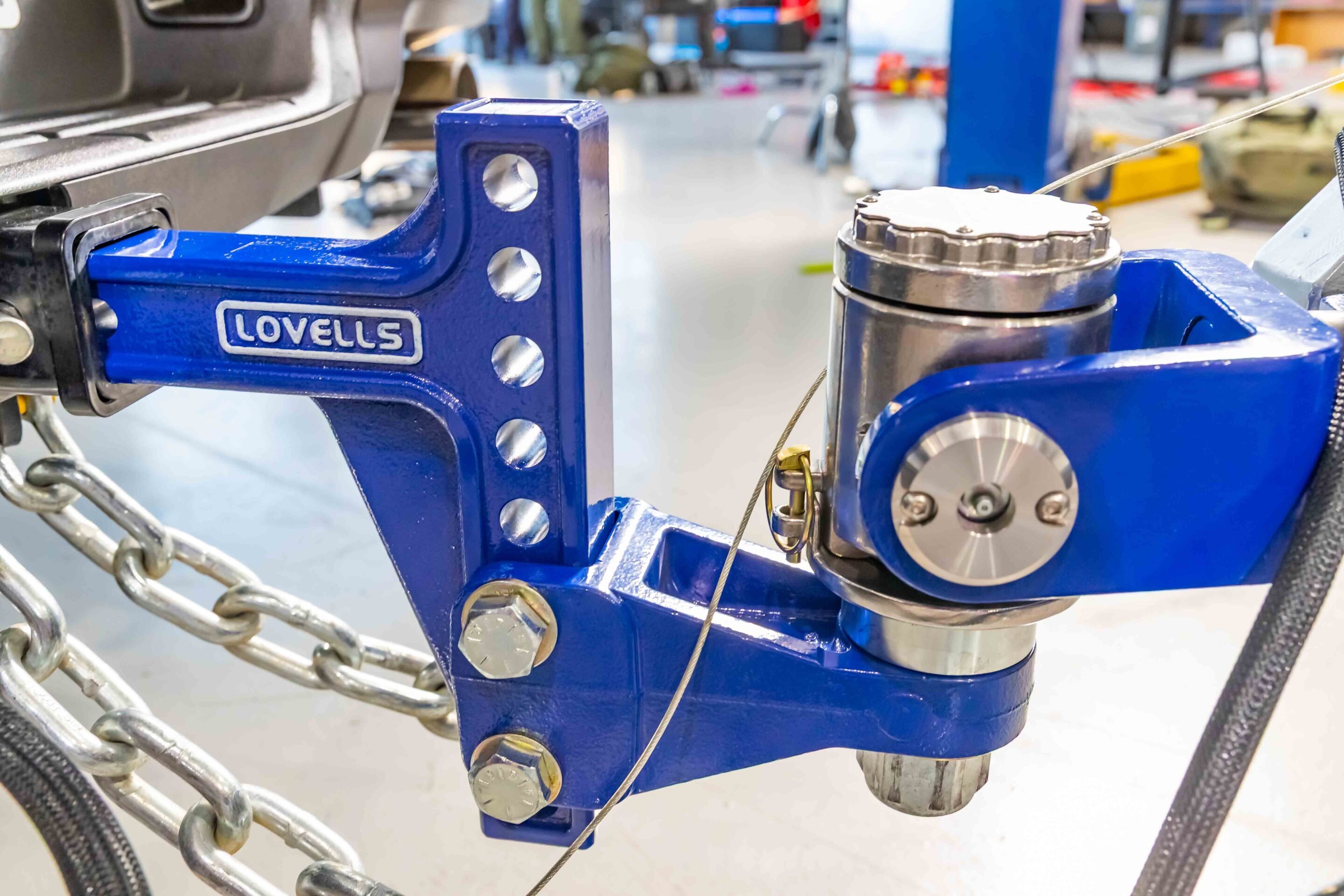
Lovells Haulace 5.5t all‑terrain coupling
- RRP: $899
Made in Newcastle, the ADR-compliant Lovells HaulAce is a 5.5-tonne-rated off-road coupling designed for caravans, toy haulers and heavy-duty trailers. It features 360-degree articulation, a drop-on connection and a Duplex stainless steel head. Built for harsh Australian conditions, the HaulAce is fully weld-on and complies with ADR 62/02 for safety and performance. Quick to hook up and built to last, it’s a tough and reliable option for serious towing. 🔧 View product details
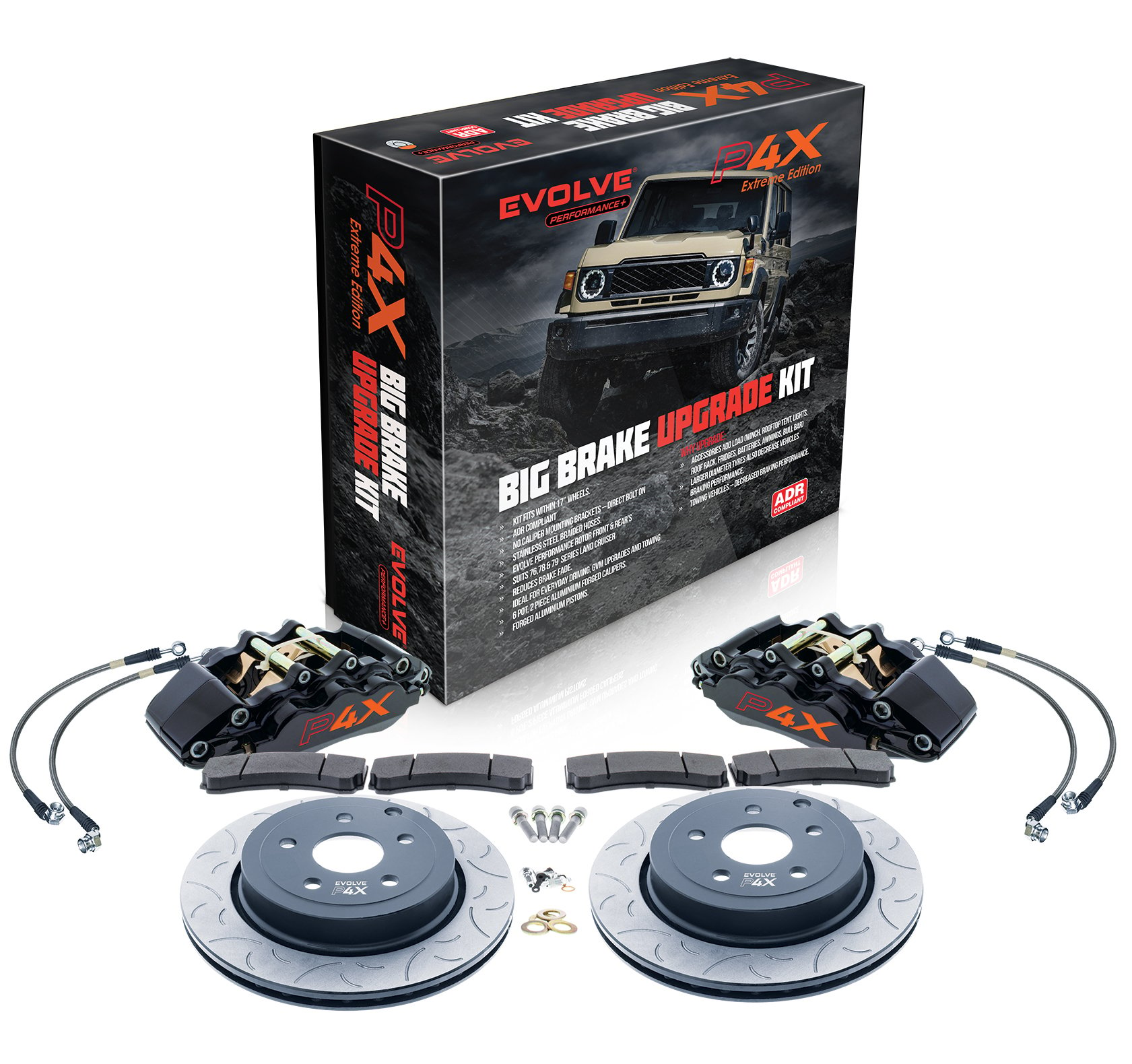
Bremtec Big Brake Upgrade kits
- RRP: POA
Available through Adventure Industries, Bremtec’s ADR-compliant P4X Big Brake Upgrade Kits are designed to improve braking performance when towing, off-road or carrying heavy loads. Suitable for vehicles running 17-inch wheels or larger, the kits include high-carbon Evolve P4X rotors with thermal paint indicators, corrosion-resistant coating and aggressive hyper slotting.
Each kit also includes copper-free Pro-Line P4X ceramic pads, braided stainless steel hoses, and lightweight two-piece six-piston aluminium calipers with forged pistons. Kits are available for Ford Ranger PY, Raptor and VW Amarok NF, as well as the Toyota LandCruiser 76, 78 and 79 Series. Rotors and HD4X pads are also sold separately.
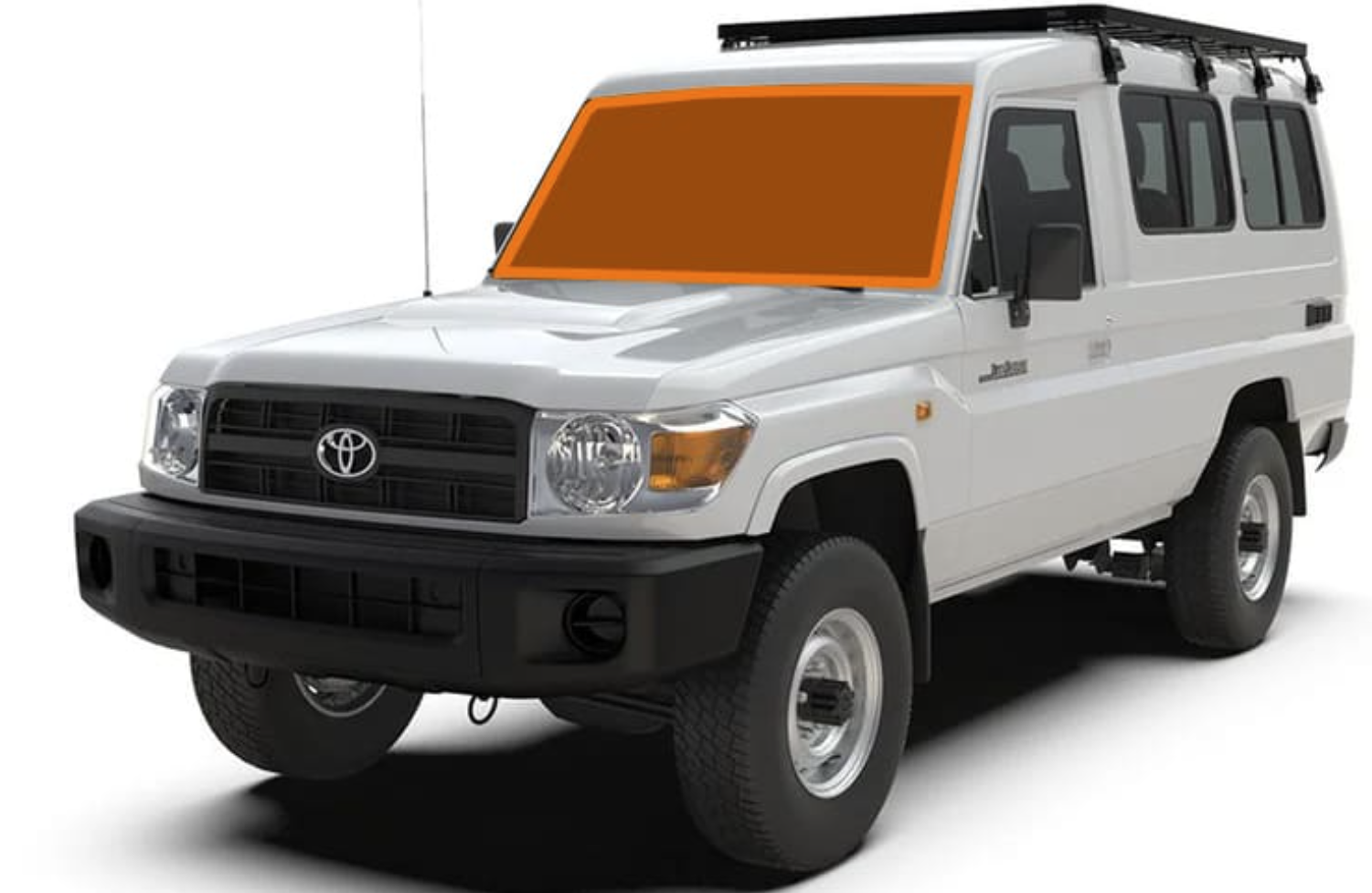
Living In A Bubble window covers – TroopCarrier
- RRP: $99.95
A new range of insulated window covers for the Toyota LandCruiser TroopCarrier is set to launch in September. Designed for privacy, thermal insulation and complete light block-out, the covers help keep the vehicle cooler in summer, warmer in winter and more comfortable year-round. The full set includes covers for the windscreen, front windows, side glass and rear barn doors, offering all-round protection and reduced heat transfer.
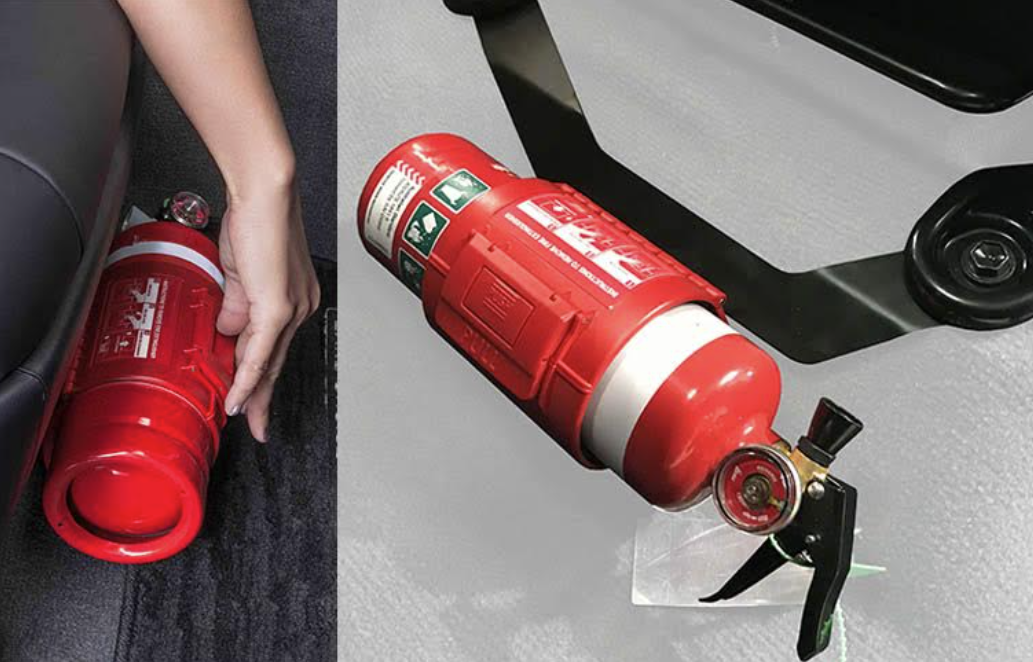
NSV Quick Release Extinguisher Clamps
- RRP: $110
Designed for 1kg fire extinguishers (80mm diameter), NSV’s Quick Release Clamps allow fast, one-handed access in an emergency. The simple latch system avoids fiddly locks or moving parts, making it easy to operate under pressure. Each kit includes a powder-coated steel bracket tailored to specific vehicles and takes around 20 minutes to install. The system meets ECE and ADR standards and has been extensively crash tested. Fire extinguisher not included. 🔧 View product details
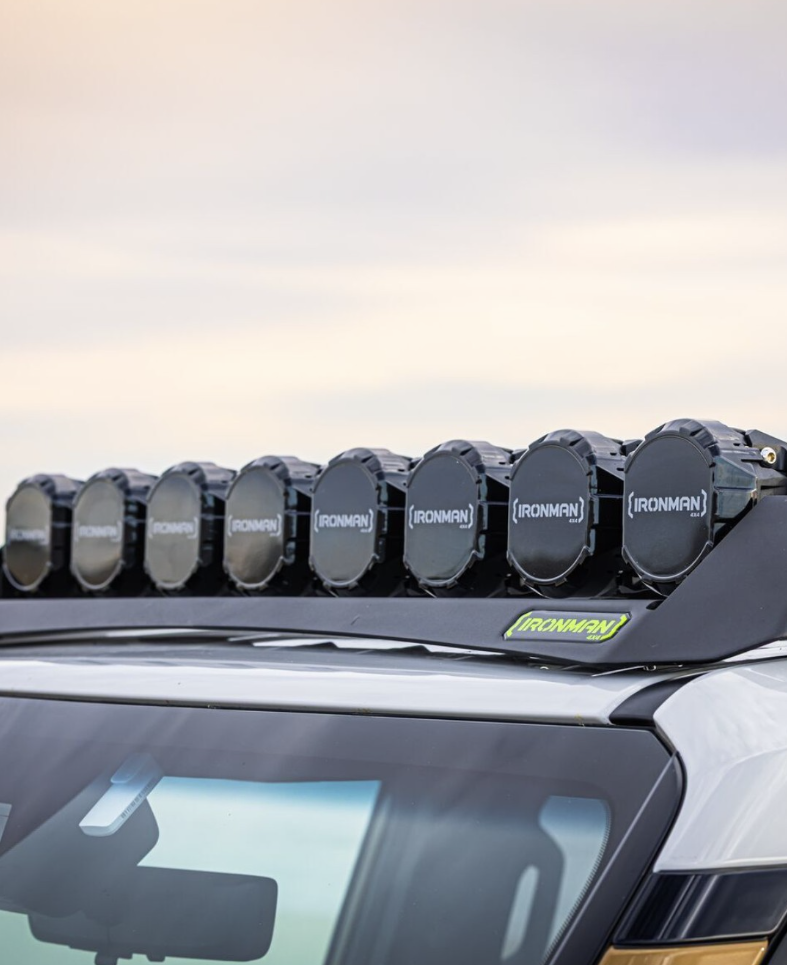
Ironman 4×4 Scope 42-inch light bar
- RRP: $1699
Pumping out over 35,000 raw lumens, Ironman 4×4’s 42-inch Scope light bar uses Total Internal Reflection (TIR) lenses and hooded reflectors to deliver a broad, usable beam ideal for off-road driving. Efficiency is rated at 88.9 per cent. High-output OSRAM LEDs are mounted directly to a cast aluminium housing for better heat management. The bar is designed to fit Ironman’s Raid roof rack and includes a wiring harness, black lens covers and an illuminated logo that doubles as a DRL. 🔧 View product details
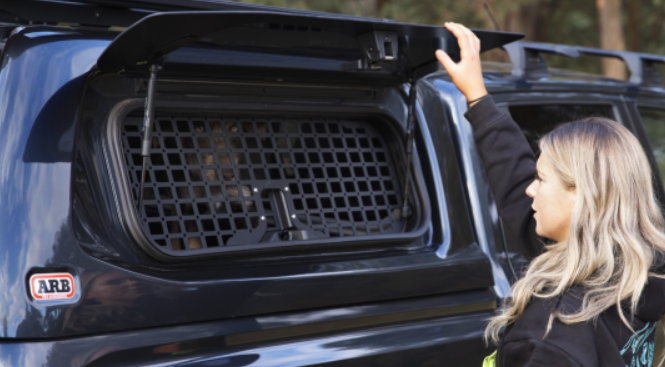
ARB Security Mesh
- RRP: Optional with ARB canopies
ARB’s Security Mesh adds an internal steel barrier to your canopy, helping deter theft while maintaining airflow and rear visibility. Made from laser-cut, powder-coated steel, it also provides MOLLE mounting points for gear such as 12V controls, tools or storage pouches. It’s a practical addition for pet owners too, creating a secure, ventilated area when paired with the Ascent canopy’s dual-stage window catch. 🔧 View product details
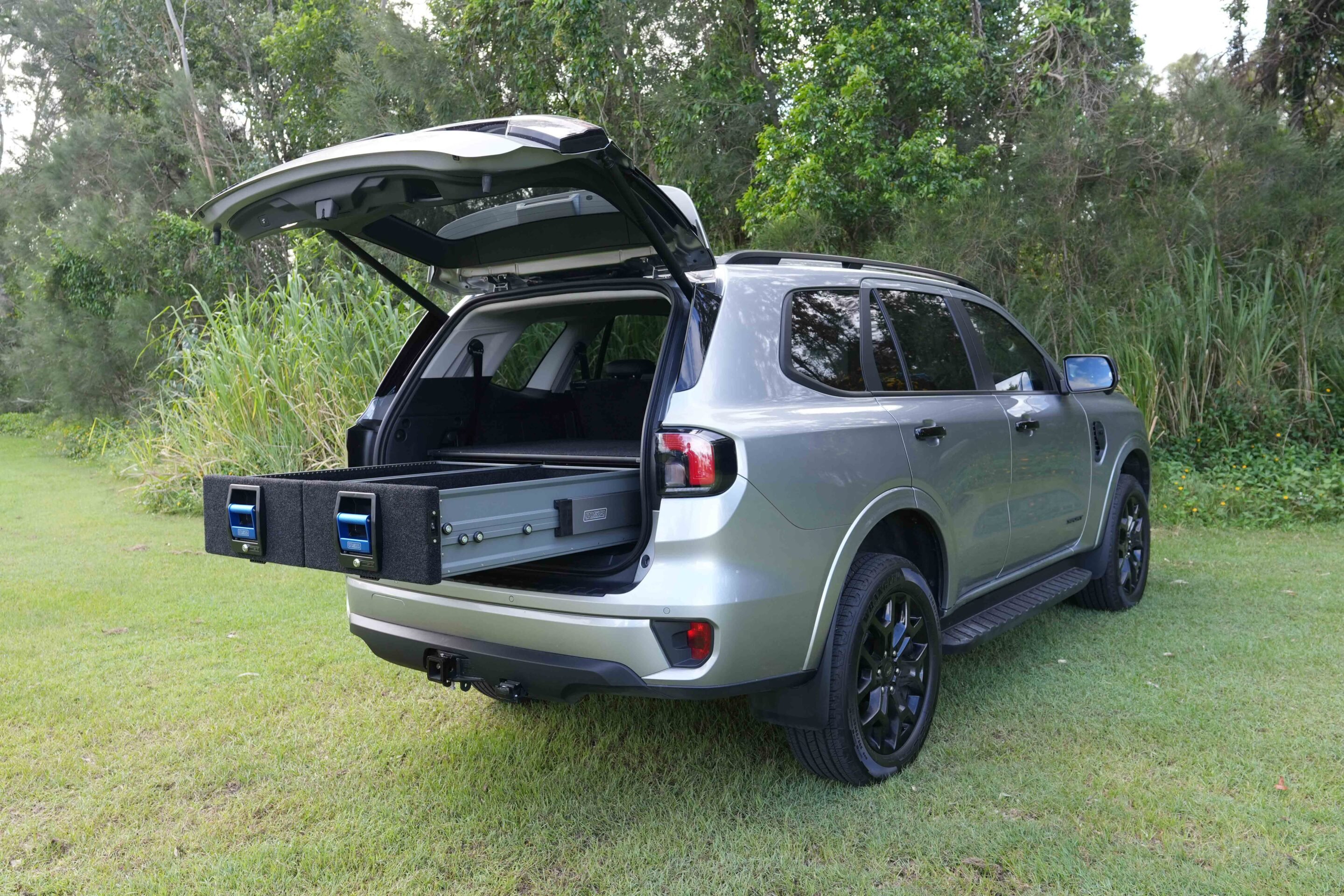
MSA 4×4 Drawer Systems – Ford Everest
- RRP: $2810 (double); $1405 (LHS or RHS)
MSA 4X4’s storage solution for the Ford Everest offers full drawer extension for easy access, with drawers running on sealed stainless steel bearings and nylon rollers for smooth, quiet operation. The patented Stay-Open Block holds drawers open on slopes up to 30 degrees.
Built from aluminium with stainless fasteners, the system features dust seals, an internal LED light, tamper-resistant locks and reinforced mounts for fridge slides. Removable wing panels provide access to side cavities, and the unit includes a cargo barrier and child restraint points. Crash tested to ADR 3/02, 34/01 and 42. Available in double, left or right-side configurations, and backed by a lifetime guarantee. 🔧 View product details
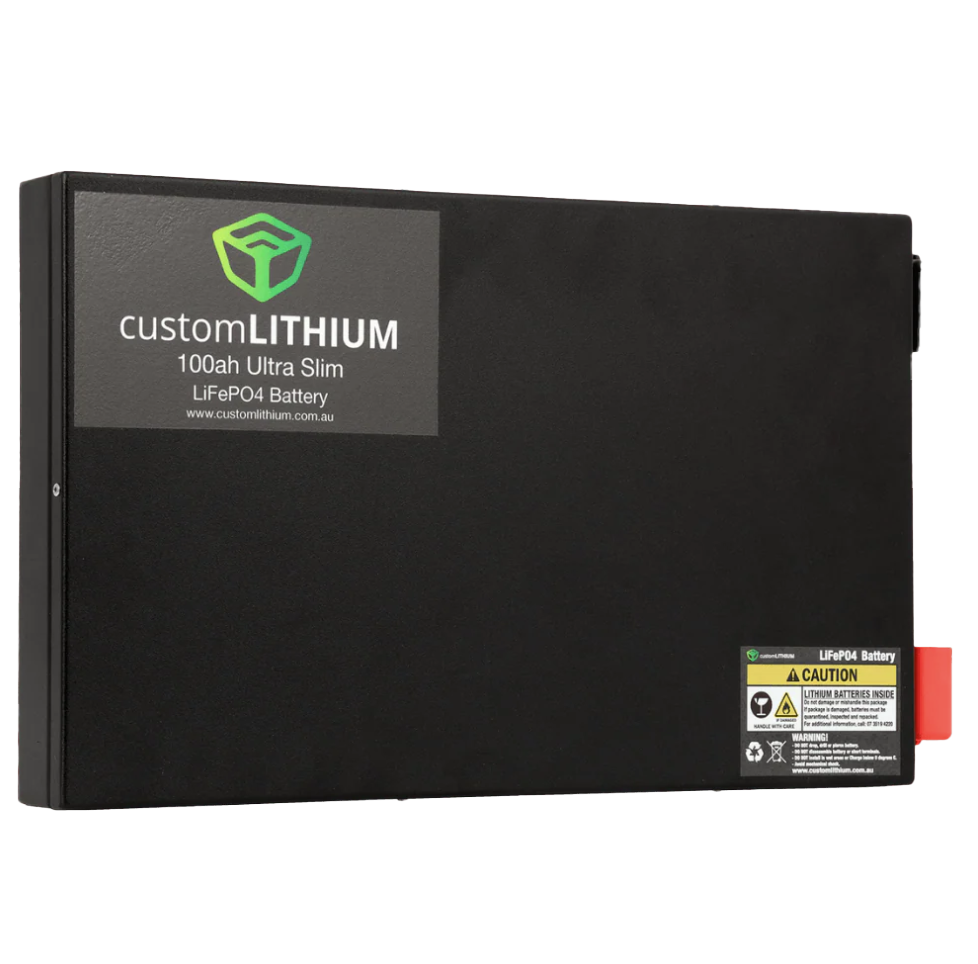
Custom Lithium Ultra Slim 100ah battery
- RRP: $1390
Custom Lithium’s 100Ah Ultra Slim battery is built for tight-fit 4×4 installs behind seats, under false floors or inside canopies. Just 55mm high, 300mm wide and 490mm long, and weighing only 14kg, it fits where bulkier batteries can’t.
Made in Brisbane and backed by a seven-year warranty, the battery uses A-grade LiFePO4 cells and features a high-current BMS with active balancing to protect against over-discharge, overheating and short circuits. The aluminium enclosure is built to handle heat, vibration and impacts in harsh off-road conditions. Specs include 180A constant discharge, 700A peak discharge and an operating range of –20°C to 60°C. 🔧 View product details
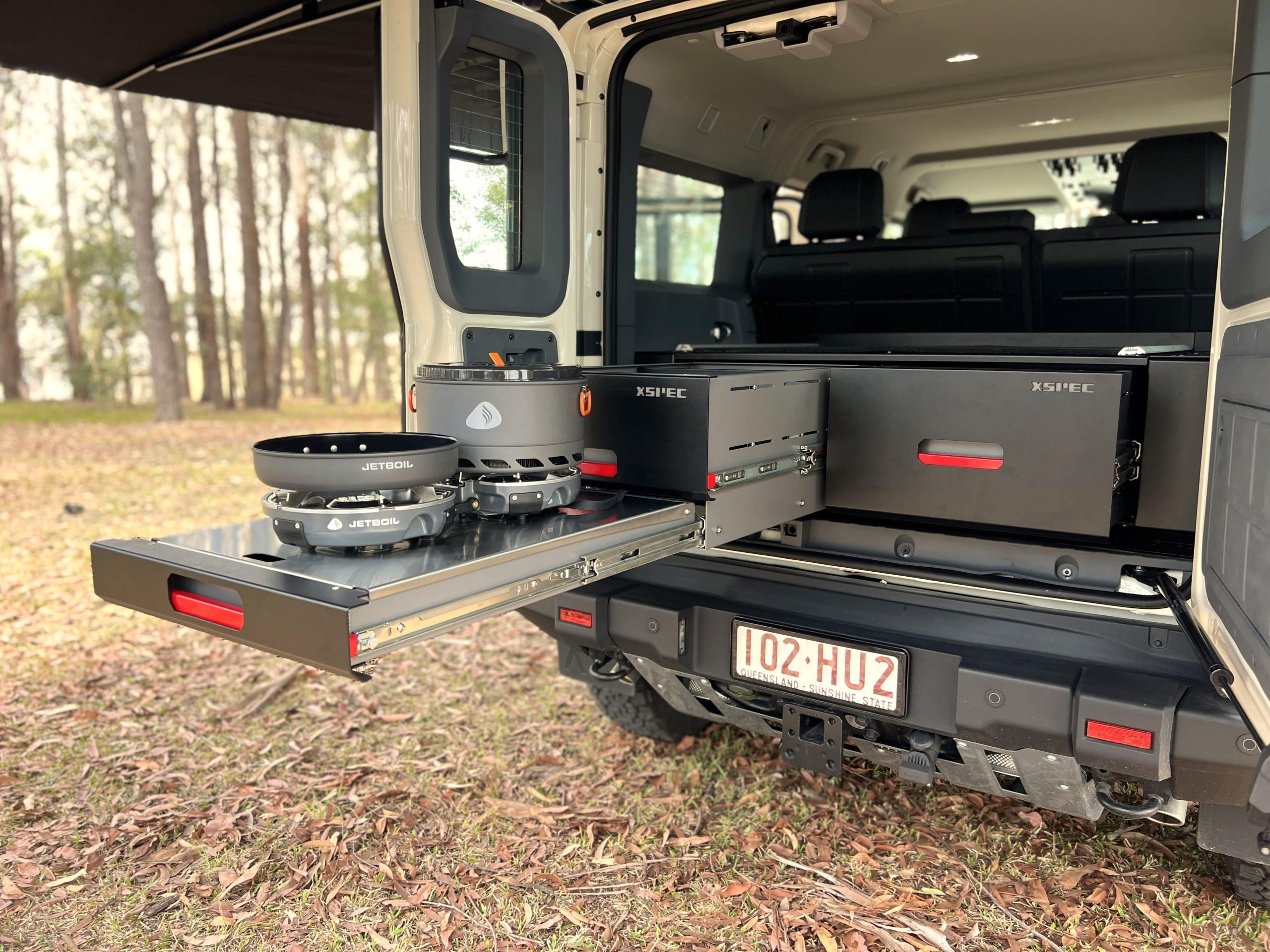
XSpec drawer system – Ineos Grenadier
- RRP: $5890
Designed specifically for the INEOS Grenadier, the XSpec drawer system is a heavy-duty aluminium setup built for serious touring and storage needs. It mounts directly to the vehicle floor via a strong base frame and stainless steel hardware, with three welded drawers on heavy-duty locking runners and one-handed latches.
The right and upper left drawers both feature adjustable dividers for larger gear, while the lower left drawer double-extends from beneath the upper unit and includes a flip-up stainless benchtop for cooking or workspace. There’s additional storage underneath for utensils or tools. Wheel arch storage and jack access are retained via removable side lids. The unit is powdercoated for corrosion resistance, weighs around 80kg, and stands approximately 350mm high. Ships flatpacked; fitting available at extra cost. 🔧 View product details
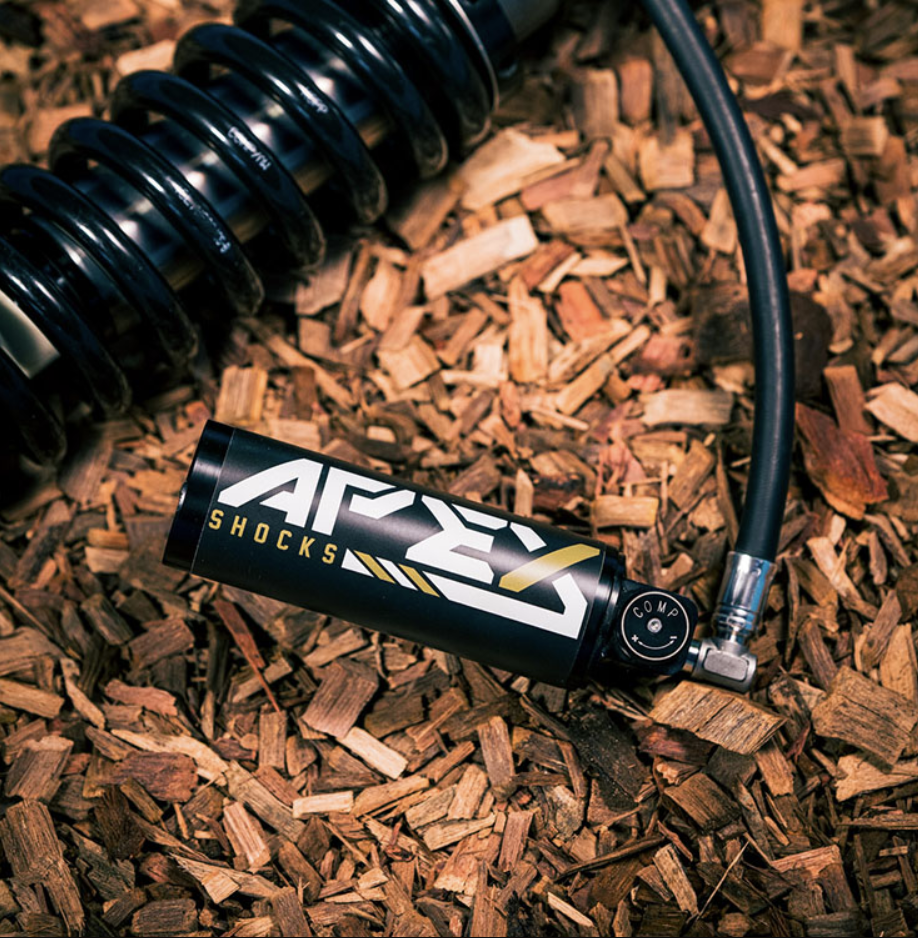
Apex Shocks suspension upgrades
- RRP: POA
Apex’s 2.5-inch (65mm) shocks feature external compression and rebound adjusters for dialling in ride and handling to suit conditions and load. Built tough, they use high-temp oil, remote reservoirs made from 6061-T6 aluminium, and 22mm hardened chrome shafts for long-term durability.
Remote canisters are linked via braided rubber hoses and stainless high-flow fittings. Kits are available for popular platforms including the LandCruiser, Silverado 1500 and Patrol Y62, with more applications in the pipeline. Backed by a 12-month unlimited-kilometre warranty and local support. 🔧 View product details
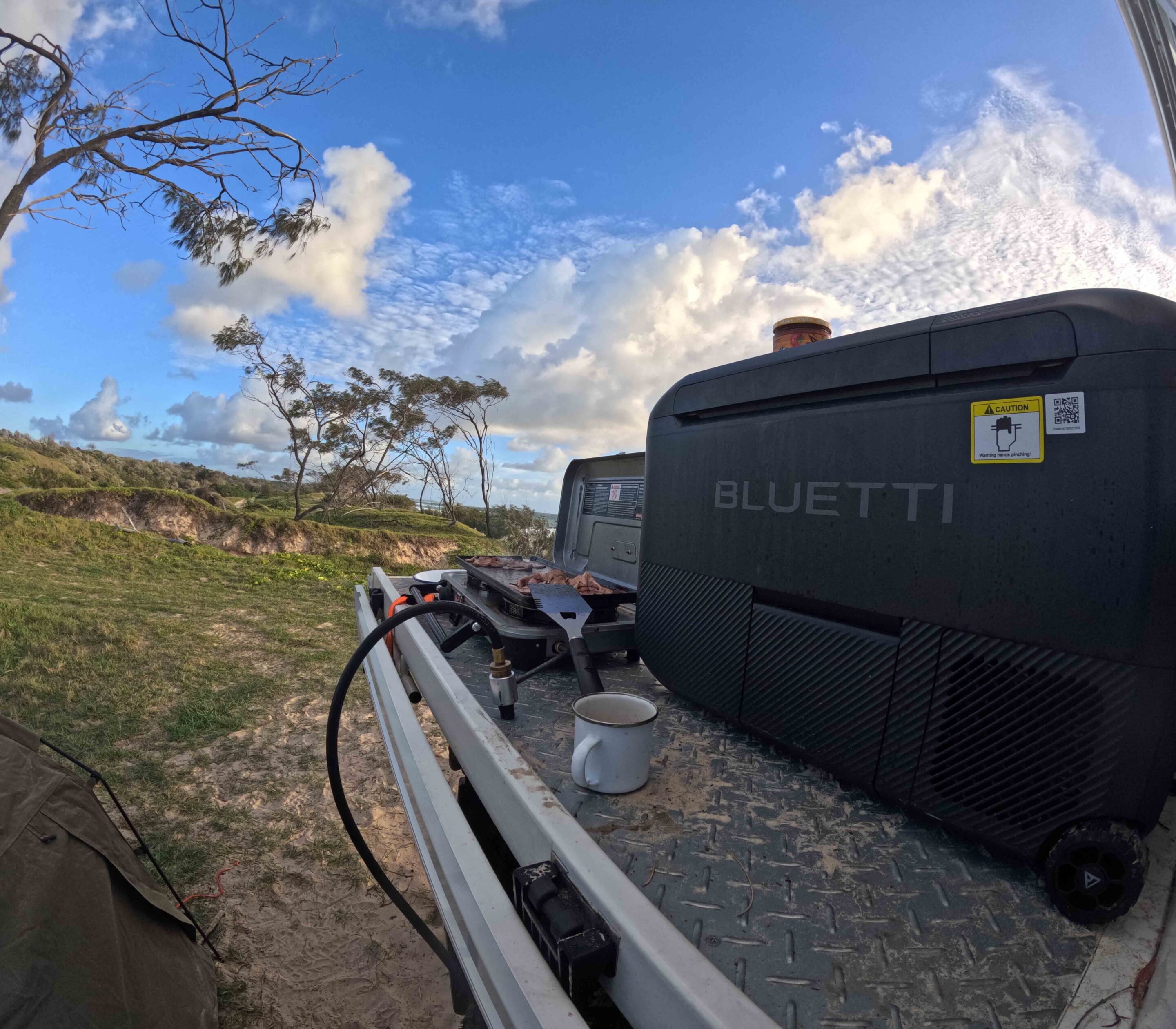
Bluetti Multicooler Fridge + AC180T Power Station
- RRP: $3798
Bluetti’s MultiCooler combines a 40L fridge, freezer and ice maker in one portable unit powered by the modular AC180T Power Station. With the optional B70 LiFePO₄ battery (716.8Wh), it offers up to three days of cooling per charge and cools from 30°C to 0°C in just 15 minutes.
Ideal for remote touring, it runs quietly (under 45dB), can be controlled via the Bluetti app, and includes wheels, a carry handle and 45-degree tilt protection. The B70 battery delivers over 3000 charge cycles and can be recharged via AC, solar or USB-C. The MultiCooler uses VIP insulation and a high-efficiency compressor for off-grid performance. Backed by a two-year warranty. 🔧 View product details
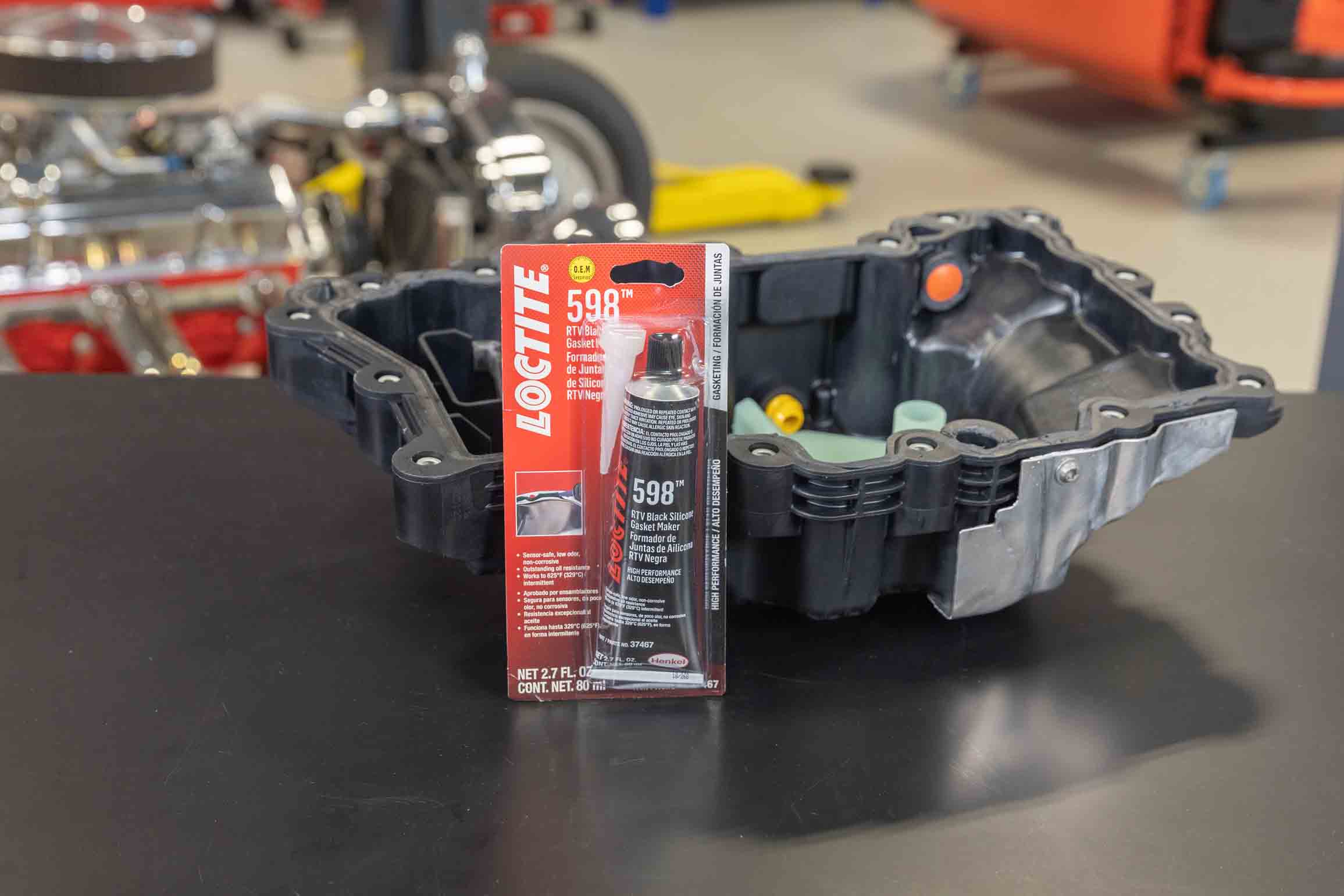
Loctite 598 RTV silicone
- RRP: $30.98
Loctite 598 is a high-performance, sensor-safe RTV silicone gasket maker designed for sealing engine, gearbox and diff components in demanding 4×4 applications. It resists oil, vibration and high heat, making it ideal for off-road use. Fast-curing and easy to apply, this black silicone is OEM-approved and delivers a reliable, leak-free seal. A handy addition to any 4×4 tool or spares kit.
Toyota’s next-generation HiLux appears to be on the verge of a showroom debut in Australia, following recent government filings that indicate the vehicle has passed local approval.
While Toyota has yet to confirm specifications, it appears the new HiLux could consolidate its engine range, with all Australian variants expected to use the 2.8-litre turbo-diesel four-cylinder 1GD-FTV. Two versions are suggested: a standard high-output model and a mild-hybrid variant, which could feature on higher-spec trims.
The filings also indicate a central front airbag for the driver and passenger, which would bring the HiLux closer to its key competitors in terms of occupant protection. The documents also reveal the extra-cab body style may be phased out.
Toyota is reportedly preparing to showcase the new HiLux in Thailand this November at the Motor Expo, where it may be marketed as the HiLux TRAVO. Leaked images of single- and dual-cab models show a refreshed front fascia with slimmer headlights, a revised grille, and updated rear lighting on dual-cabs. The overall proportions suggest a major facelift rather than a complete redesign, with the ute expected to remain on the existing IMV platform.
Inside, early glimpses point to a more advanced cabin, featuring dual 12.3-inch screens for both the instrument cluster and infotainment, with design cues drawn from the LandCruiser Prado. The diesel engines are expected to return with updates to meet emissions standards, while mild-hybrid and possibly a plug-in hybrid variant could join the lineup, keeping the HiLux competitive with rivals such as the Ford Ranger and BYD Shark.
Final specifications remain unconfirmed.
The Warrior sits in a funny position in the ute market. It’s not a Raptor rival, not a budget spec either.
It’s Nissan’s halo dual-cab, built here by Premcar, tuned for Aussie roads and bush, specced with tyres and suspension that actually work, and wrapped with the comfort of a full factory warranty.
I spent a week with it across SA, dragging an Offline Domino Camper 650km from Adelaide. Highways, coarse-chip blacktop, fast gravel, steep rocky climbs, and the Domino’s 1200kg hanging off the back – then we did the fun stuff. Unhitched we hit the Adelaide Hills 4WD Park and its Black-rated tracks to see how far you really can go on a stock Nissan.
JUMP AHEAD
- What does it come with?
- How it stacks up against rivals
- Engine and drivetrain
- Premcar suspension upgrades
- Off-road performance
- On-road performance
- Towing and payload
- Cabin and tech
- Safety features
- Warranty and servicing
- Recommended mods
- Verdict
- Specs
What does the PRO-4X Warrior come with?
The PRO-4X Warrior is Nissan’s flagship dual-cab ute in Australia.
Built on the PRO-4X, Premcar re-engineers suspension, protection, and rolling stock to suit Aussie conditions. This test included highway kays, rough bush tracks, and towing the Domino camper.
This isn’t just a Navara with stickers. Premcar reworks the already decent PRO-4X with new springs, dampers, jounce bumpers (progressive-rate bump stops), a specially designed towbar that clears a full-size spare, thicker bash plates, full underbody protection, and Cooper AT3 all-terrains.
Crucially, the whole package is ADR-approved and sold as a genuine Nissan, meaning you get the same five-year, unlimited-kilometre warranty and nationwide dealer support as any showroom Navara. That’s the Warrior’s ace – it gives you engineered upgrades without the aftermarket headaches.
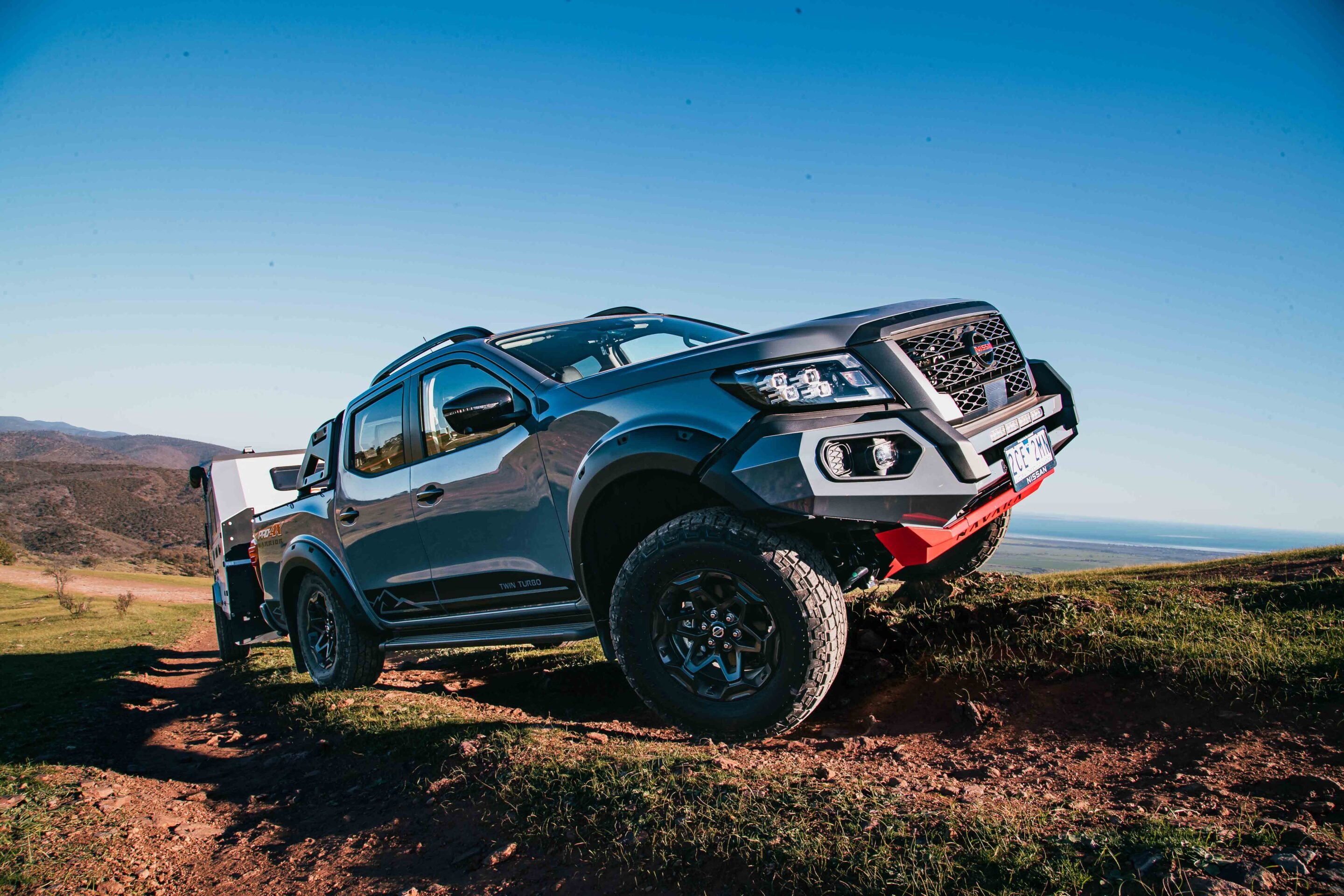
How it stacks up to rivals
The PRO-4X Warrior’s closest rivals sit at the premium end of the dual-cab spectrum: Toyota’s HiLux GR Sport, Isuzu’s D-MAX Blade, and Ford’s Ranger Wildtrak-X. Each takes a similar approach, they all land in the same buyer’s crosshairs.
The HiLux GR Sport is Toyota’s toughest showroom ute to date. At $73,990 plus on-roads, it’s a touch pricier than the Warrior once you’re on the road, but it justifies some of that with more power and torque. Its 2.8-litre diesel with 165kW/550Nm, giving it a healthy 100Nm advantage over the Warrior. On paper that matters for towing, though its 5850kg GCM is actually lower than Nissan’s, and its 735kg payload is pretty substandard. Its platform age is also showing: the GR Sport sits on the 2015-era HiLux chassis, with refinements but no clean-sheet changes.
The Isuzu D-MAX Blade, at $76,990 drive-away, is the most expensive of this trio but brings Walkinshaw’s suspension expertise to the table. Its 3.0-litre four-cylinder diesel (140kW/450Nm) matches the Warrior for outputs but is better known for durability than refinement. Payload is healthier than the GR-S at 970kg, and its 6000kg GCM gives it more practical towing headroom. The Blade’s strength is out-of-the-box off-road traction – thanks to Rough Terrain Mode and aggressive Goodyear Duratracs – though it too sits on a relatively new platform, launching in 2020.
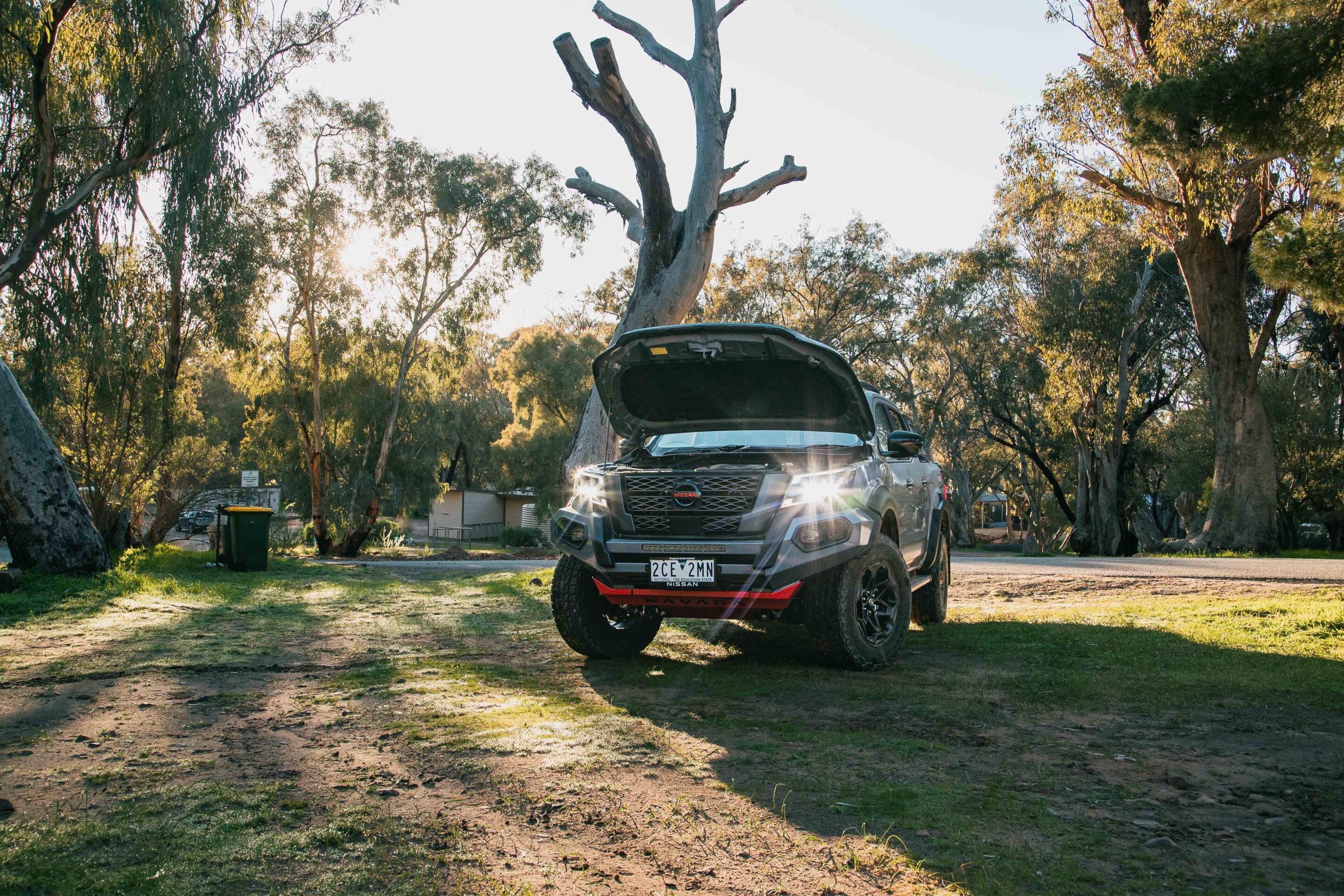
Then there’s the Ford Ranger Wildtrak-X, which debuted as a 2023MY and is the freshest of the bunch. At $75,990 plus on-roads, it’s a little pricier than the others but sits on an all-new chassis and body that make the Navara and HiLux feel dated. Its 2.0-litre bi-turbo (154kW/500Nm) splits the difference between Nissan and Toyota for outputs, and the 10-speed auto keeps it on song.
Payload comes in at 951kg, with a GCM of 6400kg – easily the best here for touring and towing. The Wildtrak-X also adds full-time 4WD and more modern safety tech, which makes the Warrior’s hydraulic steering and basic driver aids feel old-hat.
Taken together, the Warrior undercuts the competition slightly on price, and its suspension package is arguably better balanced for Aussie touring than either. But it cannot hide its 2014-era D23 platform. Against the brand-new Ranger, the Nissan feels like the older design it is – capable and confidence-inspiring, but a generation behind in cabin and driveline refinement.
Engine and drivetrain
Under the bonnet is the familiar 2.3-litre twin-turbo four-cylinder diesel, producing 140kW and 450Nm.
It’s paired with a seven-speed automatic and part-time 4WD with low range. Premcar doesn’t touch the driveline, and honestly, we wish they did. The Warrior feels engineered everywhere else, but the engine and gearbox are unchanged.
With the Domino behind, it holds 110km/h on the flat comfortably, but hills or overtakes expose the lack of grunt. Downshifts come quickly and while it hauls through, it’s never effortless. Compared to the HiLux GR Sport’s extra 100Nm or the Ranger V6’s 600Nm, the Warrior feels under-gunned.
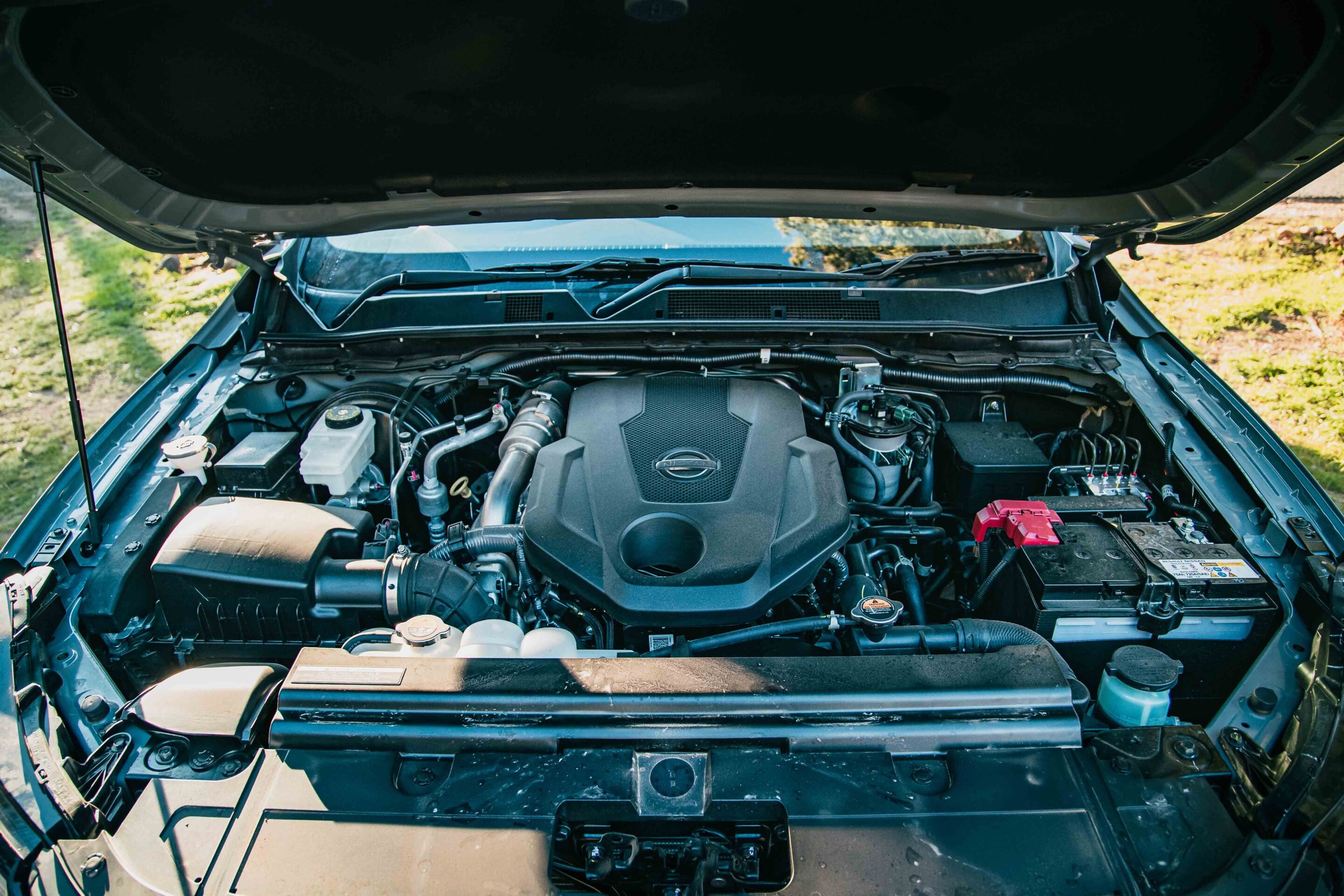
Unhitched, it’s adequate rather than exciting. Around town the twin-turbo setup delivers torque early, and the auto is tuned for smooth, lazy shifts. Hydraulic steering and part-time 4WD give it an old-school feel. Engage 4H on gravel and it feels surefooted, while low range creeps confidently. Traction control calibration is sharp, helping it punch above its spec sheet off-road.
Noise levels are better than expected for a ute on chunky LT Coopers. Tyre hum will increase as they wear, but out of the box it’s quieter than a D-MAX, though not as refined as a HiLux or Ranger V6. At the end of the day, the driveline is the Warrior’s limiting factor. More power would transform it from “capable” to “competitive.”
Premcar suspension upgrades
The Warrior’s suspension is its calling card, and it’s where Premcar’s fingerprints are most obvious. The work is not cosmetic – it’s real re-engineering.
Up front, the coil springs were softened by about 7%, allowing the front end to settle more naturally over small bumps and corrugations. Steering inputs feel calmer, with less kickback through the wheel, which pays dividends on long highway runs and when nosing into rocky climbs.
The rear uses a clever dual-rate progressive spring: the primary stage softened by around 6% for compliance over everyday bumps, while the secondary stage stiffened by about 13% to keep the ute level under payload or ball weight. In practice, it doesn’t sag badly when you hitch a camper, but it also doesn’t rattle your teeth when unladen. It is much smoother and compliant than any leaf-spring suspension in its class.
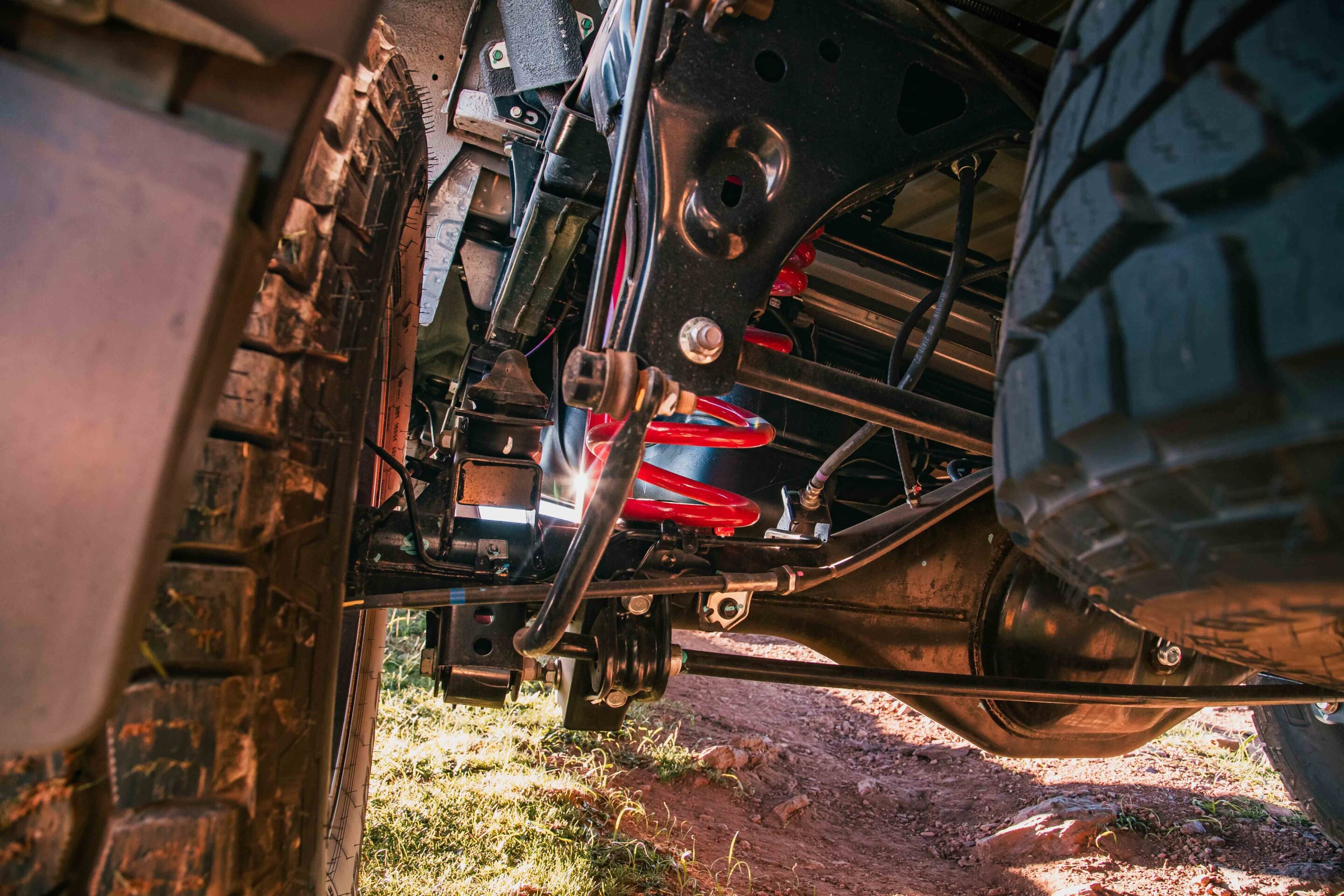
Larger-bore twin-tube shocks, tuned for the revised spring rates, add heat capacity and better control over long corrugated stretches. On test they resisted fade even after hours on fast gravel and kept the chassis composed with the Domino’s 150kg of ball load. The jounce bumpers (progressive-rate bump stops) deserve credit too: instead of a harsh thump when the suspension bottoms, they compress progressively, cushioning big hits.
All this adds roughly a 40mm lift over the PRO-4X. Ground clearance grows to 260mm, and approach, departure and breakover angles all improve. More importantly, the Warrior feels engineered to carry people and gear at speed across mixed terrain, not just bounce around like a commercial ute.
The rolling stock is equally well judged: 275/70R17 Cooper Discoverer AT3 LTs on Warrior-specific alloys. They’re load-rated, aggressive enough for clay and rock, and tough enough for sharp stones. Crucially, they’re matched to the suspension tune, avoiding the vague, floaty feel common when chunky tyres are bolted onto soft stock setups. On our SA test loop they gave consistent grip across blacktop and bush.
This suspension and tyre package is what sets the Warrior apart: less sag under load, more compliance unladen, and a level of stability that inspires confidence whether towing or touring.
Off-road performance
Ground clearance climbs to 260mm, with approach at 32°, departure at 19.8° and breakover at 23°.
On test, it walked through cross-axle sections with composure, traction control tuning is sharp, and articulation is solid. The Coopers made light work of clay and rock. Articulation isn’t LandCruiser or Prado level, but with nearly a tonne of payload capacity, that’s expected. What impressed was how planted the Warrior felt, with less axle hop and better control than rivals still running basic leaf packs.
I rarely needed the protection of the undercarriage armour – the clearance and decent departure and approach angles gave me plenty of line choice through the rocky Black-rated trails at Adelaide Hills 4WD Park. The turning circle is tight enough for switchbacks, though the heavier hydraulic steering is noticeable compared to the lighter, more modern systems in Ranger or D-MAX.
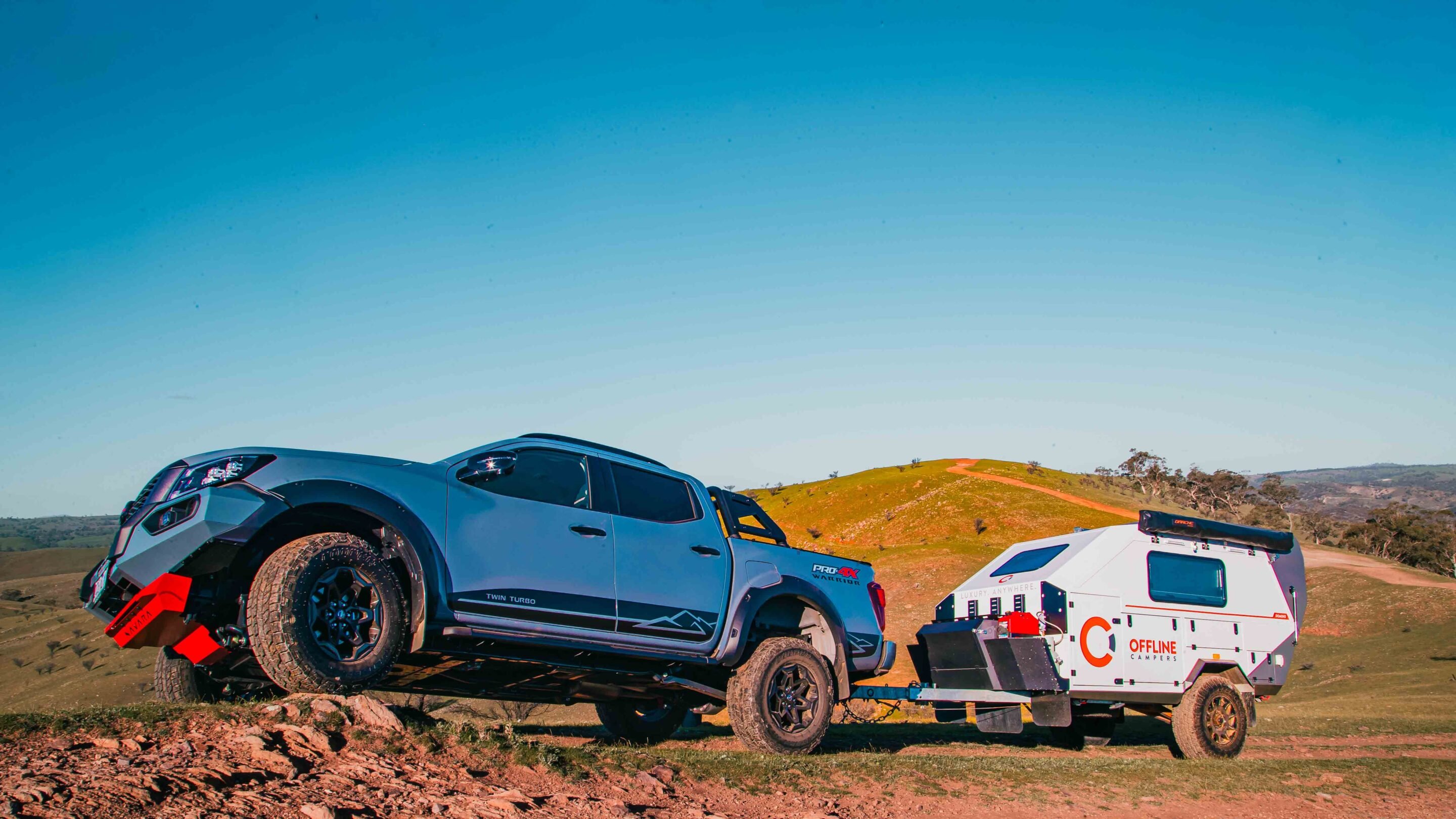
On-road comfort
A gripe here: the D23 feels made for smaller drivers. The seats could use more padding and the driving position isn’t great for taller people. Compared to a Ranger or D-MAX, it feels cramped and dated.
The ride, however, is a win. Softer coils tame harshness while the re-valved shocks and bump stops manage weight transfer well. Steering is slower than a Ranger but stable, and highway refinement is excellent for a ute on proper LT tyres.
I drove 650km with the Offline Domino hitched and 2500km without. Some utes – especially low-spec D-MAXs – need weight in the tub to ride properly. The Warrior doesn’t. With the Domino it felt more assured, with a touch more rear-end grip, but even unladen it’s one of the best-riding factory utes today, short of a Raptor.
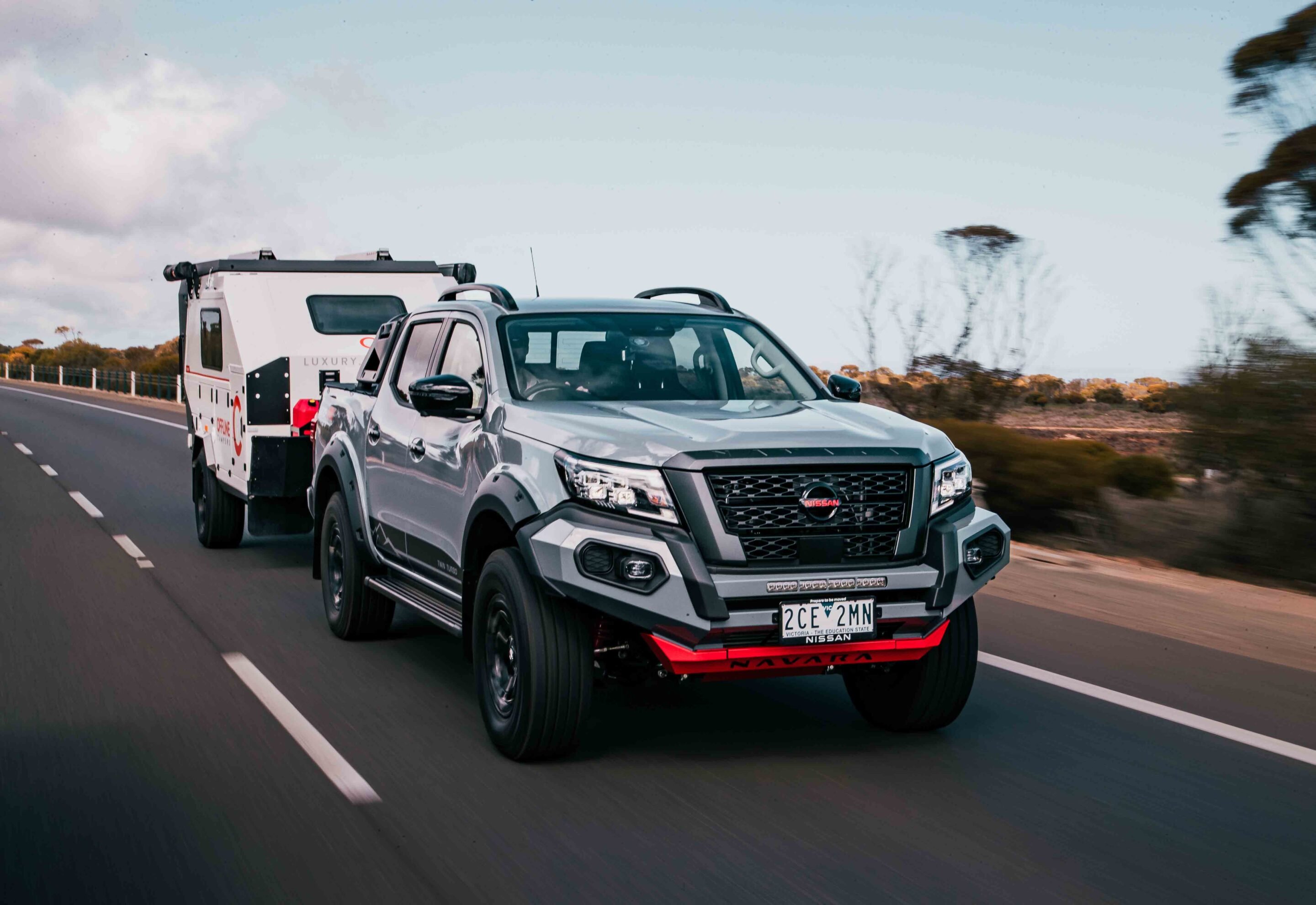
Towing and payload
With the Domino (ATM 1900kg, as seen ~1500kg) in tow, the Warrior was composed.
Reasonable low-end torque, stable suspension, and good cooling. It was not hot in SA this trip at around 15–25°C although we did punch a big headwind running up to Port Germain and the temperature needle did not move.
However, the Nav claims a big 3500kg maximum braked tow capacity. Will it do it? Yes, but you wouldn’t. Subtract the max tow capacity and your kerb weight (2298kg) from the 5910kg GCM and you’re working with 112kg for passengers and gear. The Warrior is best for towing up to 2500kg which will afford you your full payload (900kg) minus your ball weight; much better.
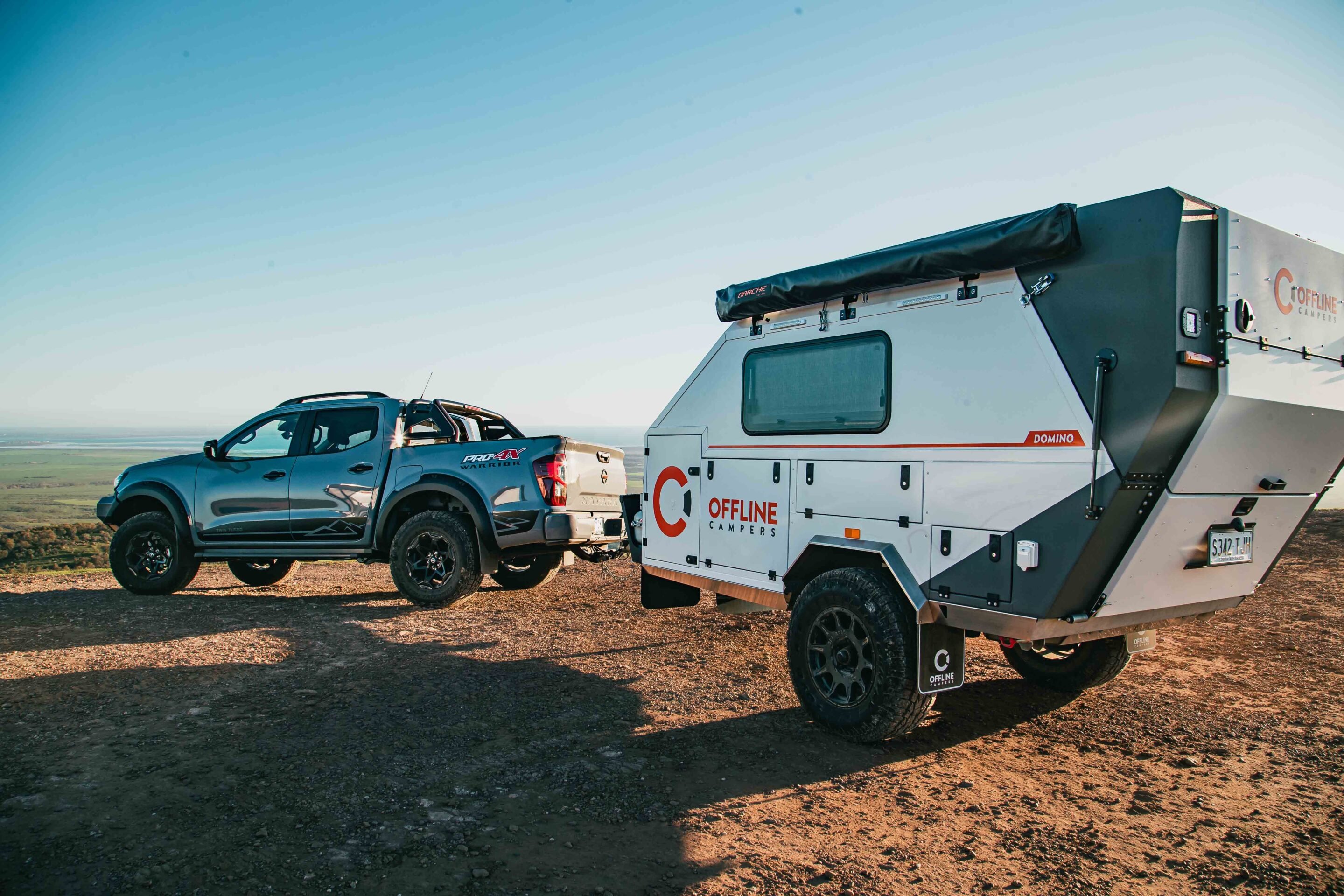
Cabin and tech
The D23 launched in 2014 and it feels it. Iterative updates have added some key tech like autonomous emergency braking and CarPlay, but like the Y62 Patrol, the interior is feeling old and outdone by its rivals.
Some will love that though as there is no intrusive lane departure assistance, just a beep when you cut road markings, and there is no driver alertness monitoring to give you the shits every time you look in the mirror or wear sunglasses.
It has leather-accented seats, an 8.0-inch infotainment screen with wired Apple CarPlay/Android Auto, and a dated but functional dash. Storage is a bit light on and the screen feels small compared to Ranger/Amarok and D-MAX. Comfort is fine for four adults, tight for five, but you’ll be fighting for USB plugs with only one and a cig point in the dash and a pair inside the centre console. If you are running a powered brake controller, phone and navigator, you’ll be frustrated like I was.
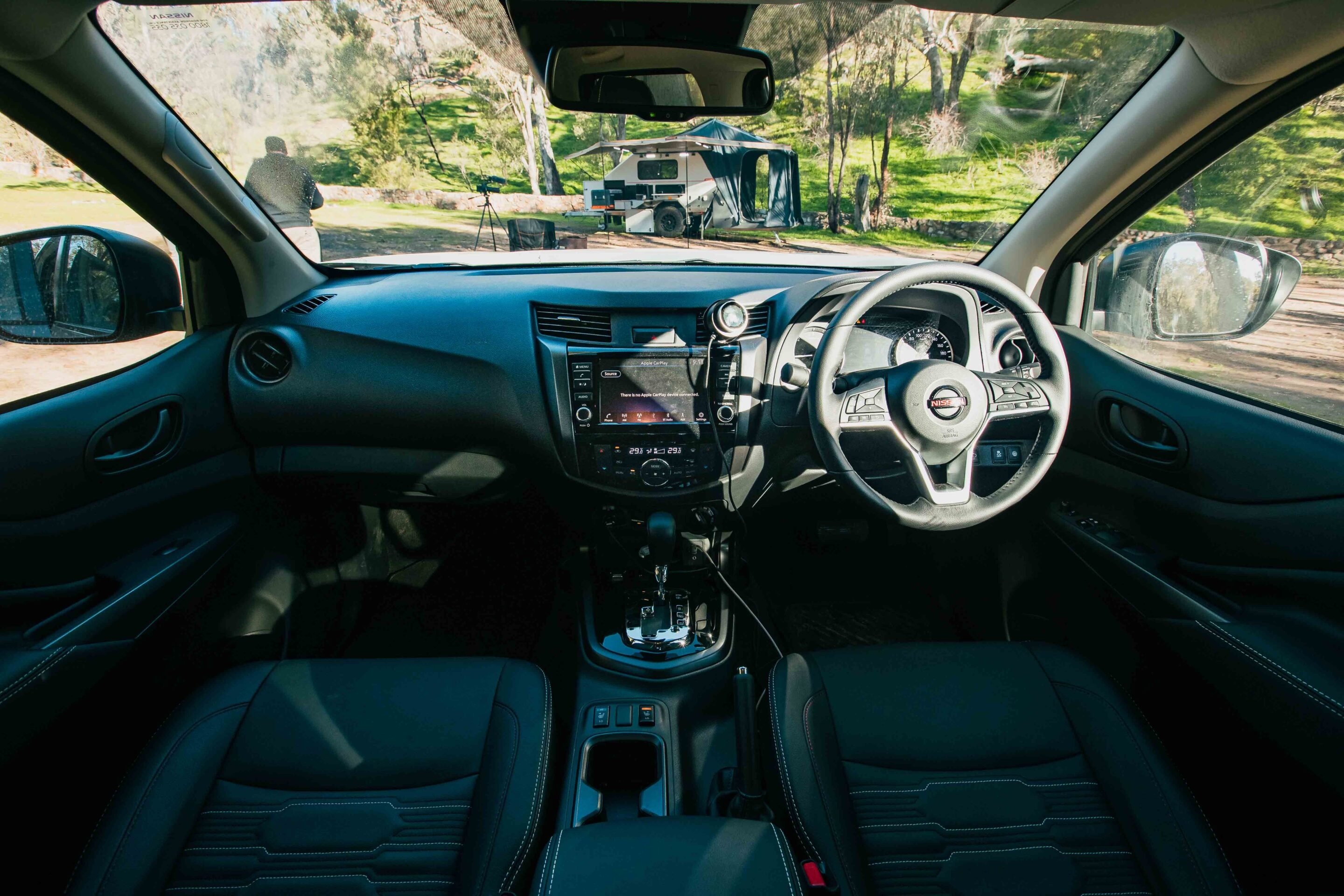
Safety features
Standard kit includes AEB, blind-spot monitoring, RCTA, lane departure warning, and 360-degree camera. Adaptive cruise is absent, and lane keep is advisory rather than active. A basic suite overall, though the 360-degree camera is a great touch even if low-definition.
Of course it has ABS and ESC which seemed fine in normal conditions. Off-road it has a dedicated Offroad Mode that holds gears right to the point of stalling – this cannot be understated enough as it really makes a difference in tight rocky tracks like we had. If the driveline is moving through gears a lot, it can jerk and cause slip at the tyres. I really enjoyed the control of the Warrior in low-speed climbs. The forward-facing and passenger-side cameras also show on the main screen when in OR mode and travelling slow, great for picking lines and avoiding the worst of the sharp rocks.
When towing there is a Tow Mode that also holds gears a bit longer, good for descents and helping keep transmission oil temps down. There is a Sport Mode but this is no Ranger Raptor. Why it has it and why you’d use it beats me.
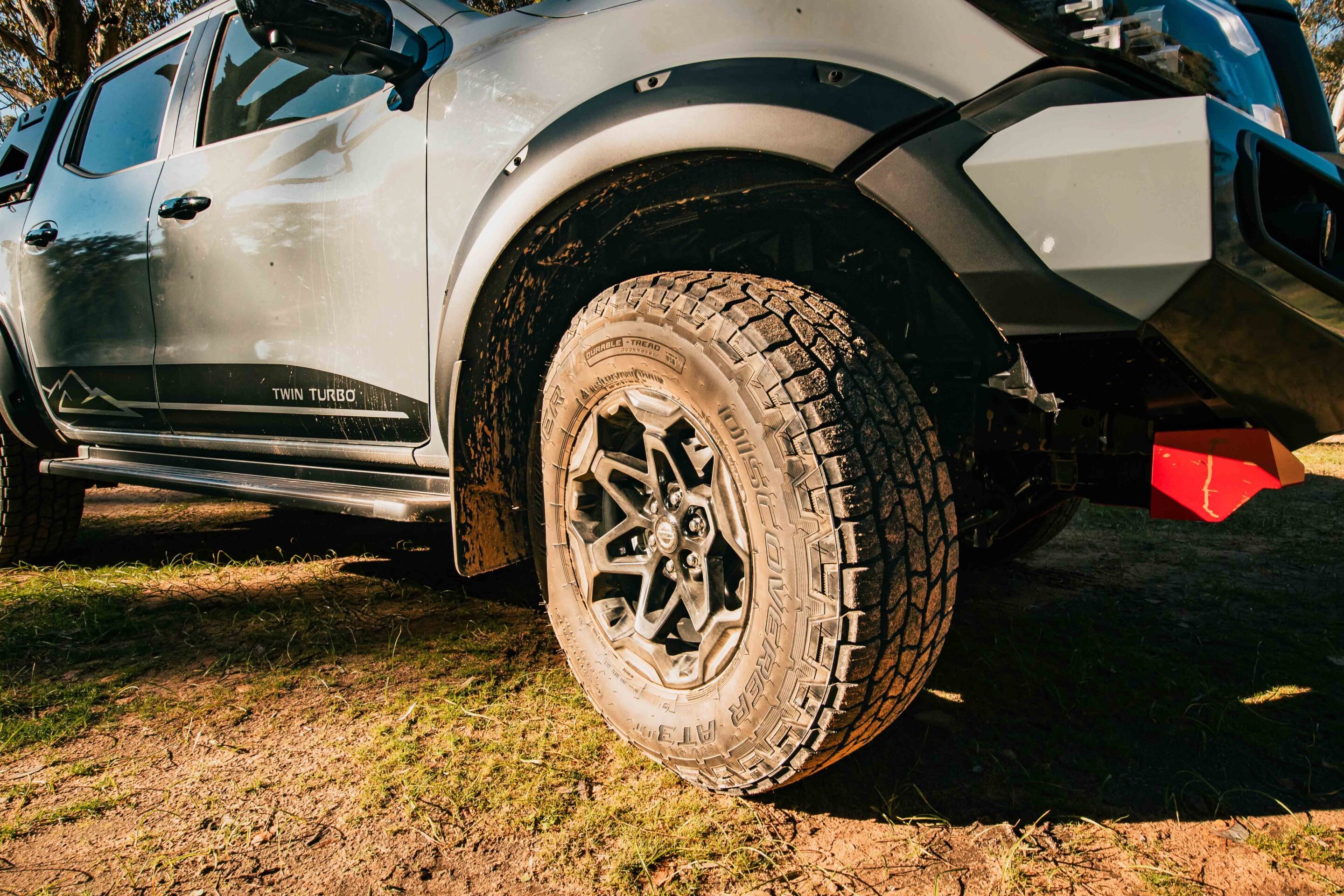
Warranty and servicing
One of the Warrior’s strongest suits is its ownership package, which stacks up well against the competition.
It’s backed by a five-year, unlimited-kilometre warranty and Nissan’s capped-price servicing program. Service intervals are set at 12 months or 20,000km, which is class-leading in the ute segment. For anyone clocking up highway kays or touring regularly, that means fewer trips back to the dealer and more time on the road. Across 100,000km, the Warrior requires just five dealer visits, costing around $3,500–$3,800 in total – roughly $700–$760 per year.
That’s competitive against the HiLux, which needs 10 visits in the same period, at a similar total cost but with double the downtime. The D-MAX undercuts both at around $2,200-$2,400 over five years, thanks to cheaper capped-price servicing, while Ford’s Ranger sits in the middle with 15,000km intervals and slightly higher costs.
Premcar’s involvement doesn’t void any of that coverage either. The Warrior is sold and backed as a genuine Nissan model, not a dealer special, so you get the reassurance of nationwide parts, dealer support and roadside assistance. For buyers worried about warranty fights on suspension mods, that peace of mind is a big drawcard.
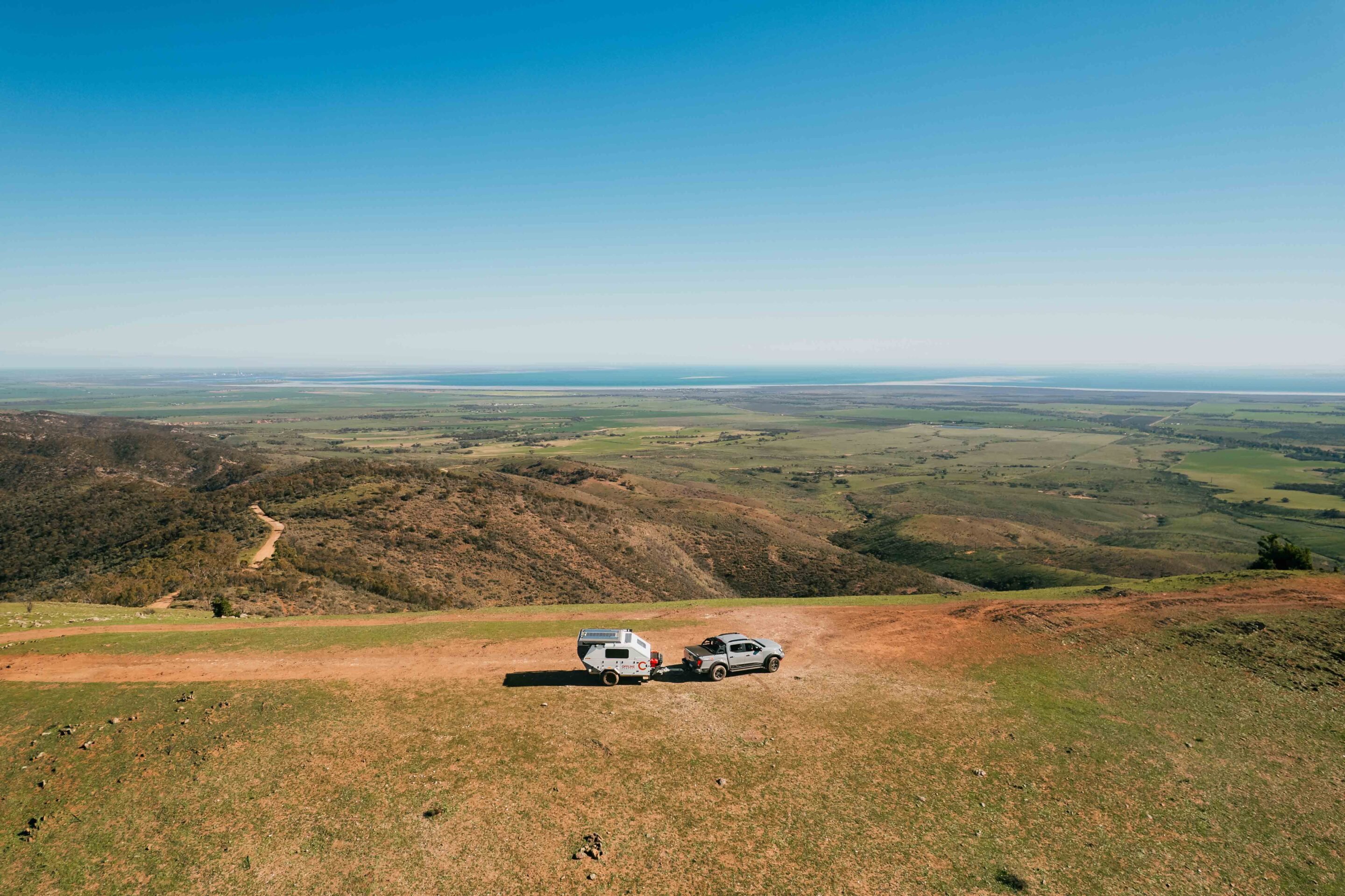
Recommended mods
The fuel tank is the obvious one. 65L is just not enough in this day and age. ARB offers a 138L Frontline tank – I would get this the day I took delivery.
The standard tyres are good enough, I would not recommend swapping them out. The same can be said of the LED lightbar and bash plates. The front bar looks hot as hell (I think this is the best-looking ute in its class) but although Nissan specs said it was winch-ready, I could not see a mounting plate on our test rig so maybe you’ll want to swap to a different front bar and winch. A power system would be a good option for anyone wanting a fridge and there is a decent space under rear seats (and behind) for a slimline setup.
The fabric tonneau cover would go in the bin for me. I’d get a tub-seal kit, some MSA drawers and a Utemaster Load-Lid – that would chew up 120kg before filling them but it would be worth it to carry a RTT or bikes. Fitting a GME XRS UHF would be a good fit for the Navara as you can fit a pass-through for the handpiece in the blanks on the lower edge of the dash and hide the handpiece in the centre console when not in use.
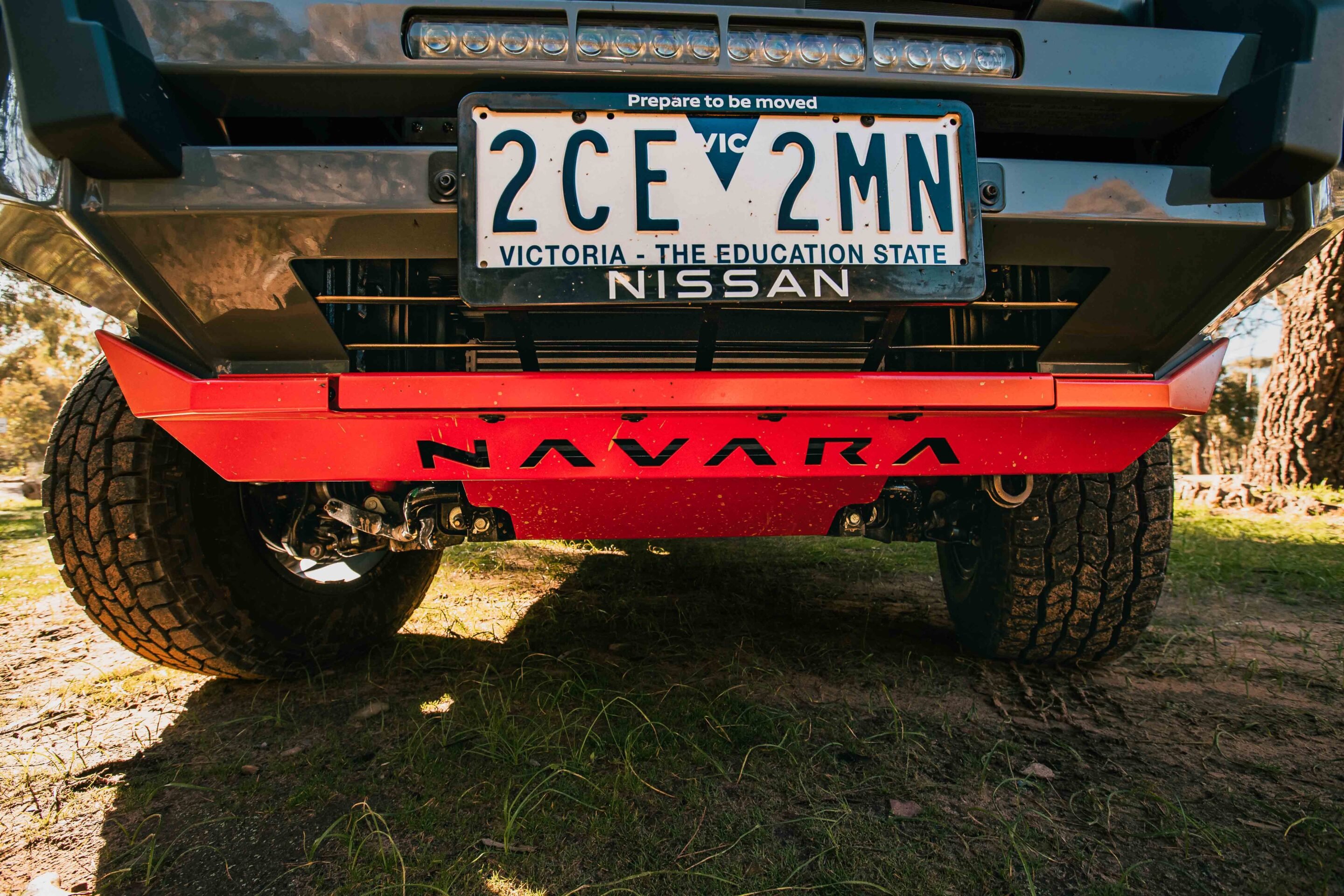
Verdict
The PRO-4X Warrior is not perfect – the cabin feels dated and cramped, and the driveline lacks the punch of newer rivals – but it’s also the most fun I’ve had in a ute since a Raptor.
It towed better than I expected, riding flat and stable with a camper in tow, and out on tracks the Premcar suspension makes it feel tougher than the spec sheet suggests. Price and servicing costs sit right alongside its competitors, but none look as good parked in the driveway. The Warrior still delivers honest, turn-key Aussie adventure appeal.
Specs
| Specification | Details |
|---|---|
| Model | Nissan Navara PRO-4X Warrior |
| Price | $67,515 + ORC (~$72-73K drive-away) |
| Engine | YS23DDTT 2.3L twin-turbo 4cyl diesel |
| Capacity | 2298cc |
| Max Power | 140kW @ 3750rpm |
| Max Torque | 450Nm @ 1500–2500rpm |
| Transmission | 7-speed automatic |
| 4×4 System | Part-time 4WD + rear diff lock |
| Crawl Ratio | Approx. 2.7:1 |
| Construction | Body-on-frame |
| Front Suspension | Independent double wishbone, coil springs, twin-tube shocks |
| Rear Suspension | Progressive rate springs, twin-tube shocks |
| Tyres | 275/70R17 Cooper Discoverer AT3 LT-AT |
| Kerb Weight | 2298kg |
| GVM | 3250kg |
| GCM | 5910kg |
| Towing Capacity | 3500kg (braked) |
| Payload | 952kg |
| Seats | 5 |
| Fuel Tank | 65L |
| ADR Fuel Consumption | 8.0L/100km |
| On-Test Consumption (Towing) | ~13.5L/100km |
| On-Test Consumption (Unhitched) | ~9L/100km |
| Approach Angle | 32 |
| Departure Angle | 19.8 |
| Breakover Angle | 23.3 |
| Ground Clearance | 260mm |
| Wading Depth | 600mm |
For 4x4s, caravans and off-grid setups, lithium batteries are increasingly common.
But there’s a lot of confusion about what they can and can’t do. This guide explains how lithium batteries work, their advantages over lead-acid, and addresses some common misconceptions.
What Are Lithium Batteries?
Most modern systems use LiFePO₄ (lithium iron phosphate) batteries. Compared to lead-acid, lithium batteries are lighter, store more usable energy, and maintain voltage consistently as they discharge. They also include Battery Management Systems (BMS) to prevent overcharging, over-discharging and overheating, which is important for off-grid or remote use.
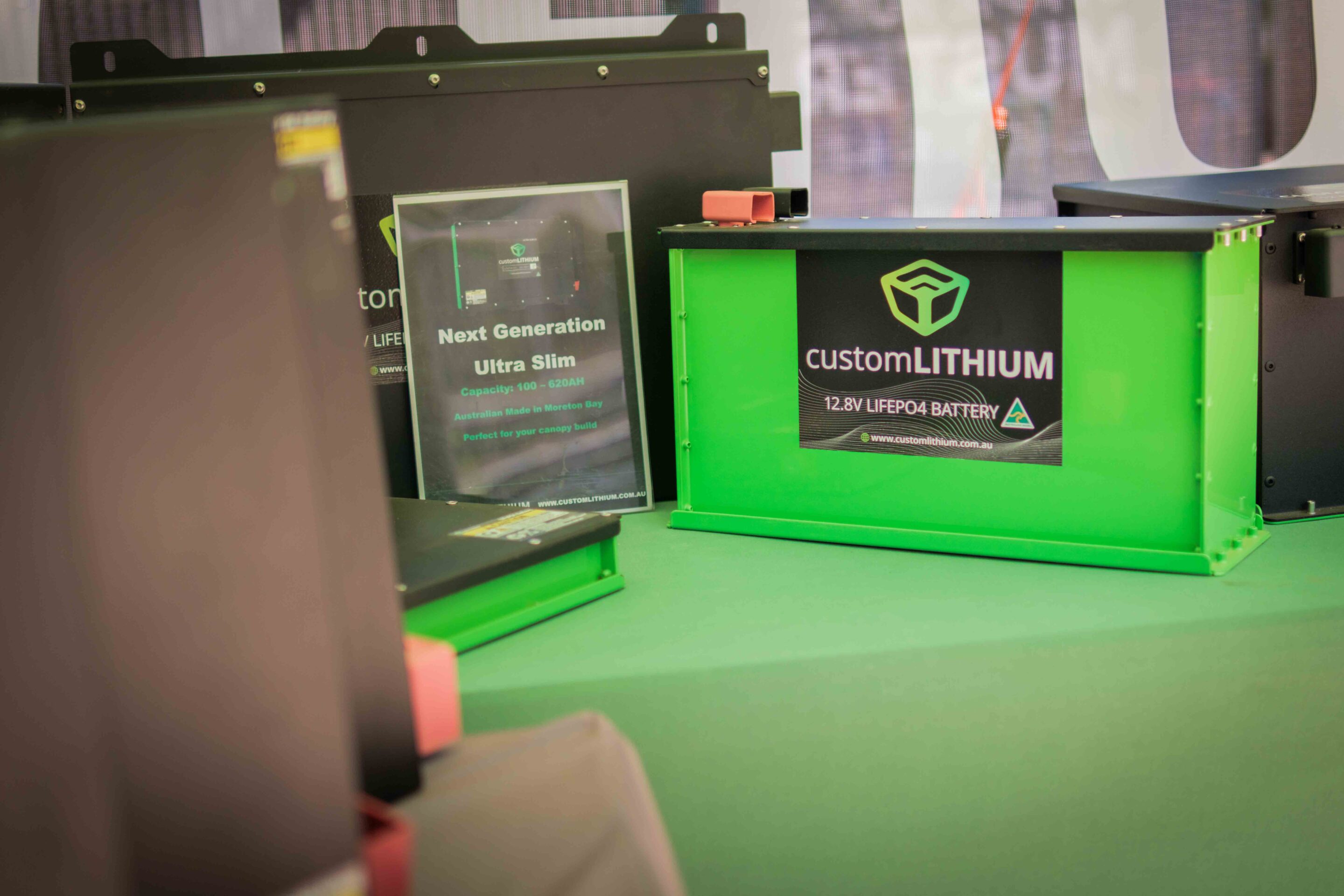
Advantages Over Lead-Acid Batteries
- Higher usable capacity: A 100Ah lithium battery can use almost all 100Ah safely, while lead-acid batteries should only use around 50 per cent.
- Lower weight: Lithium batteries are roughly half the weight of equivalent lead-acid units, freeing up payload for gear.
- Faster charging: They accept higher charging currents, so batteries recharge quicker at camp or from solar.
- Longer lifespan: LiFePO₄ batteries can last 2000 to 5000 cycles; lead-acid usually lasts 300 to 500 cycles.
- Stable voltage output: Devices run at consistent power until the battery is nearly empty.
Common myths busted
Myth 1: Lithium batteries are unsafe.
- Modern LiFePO₄ batteries include BMS and thermal protection. When used correctly, fire risk is very low.
Myth 2: They don’t work in cold conditions.
- Lithium batteries lose capacity below 0°C, but most systems include charge limits or heating options to protect the battery.
Myth 3: Lead-acid is cheaper over time.
- Lithium batteries cost more up front but last longer and provide more usable power, often balancing out the initial investment.
Myth 4: All lithium batteries are the same.
- Quality varies. Choose brands with proper BMS, warranties and a proven track record.
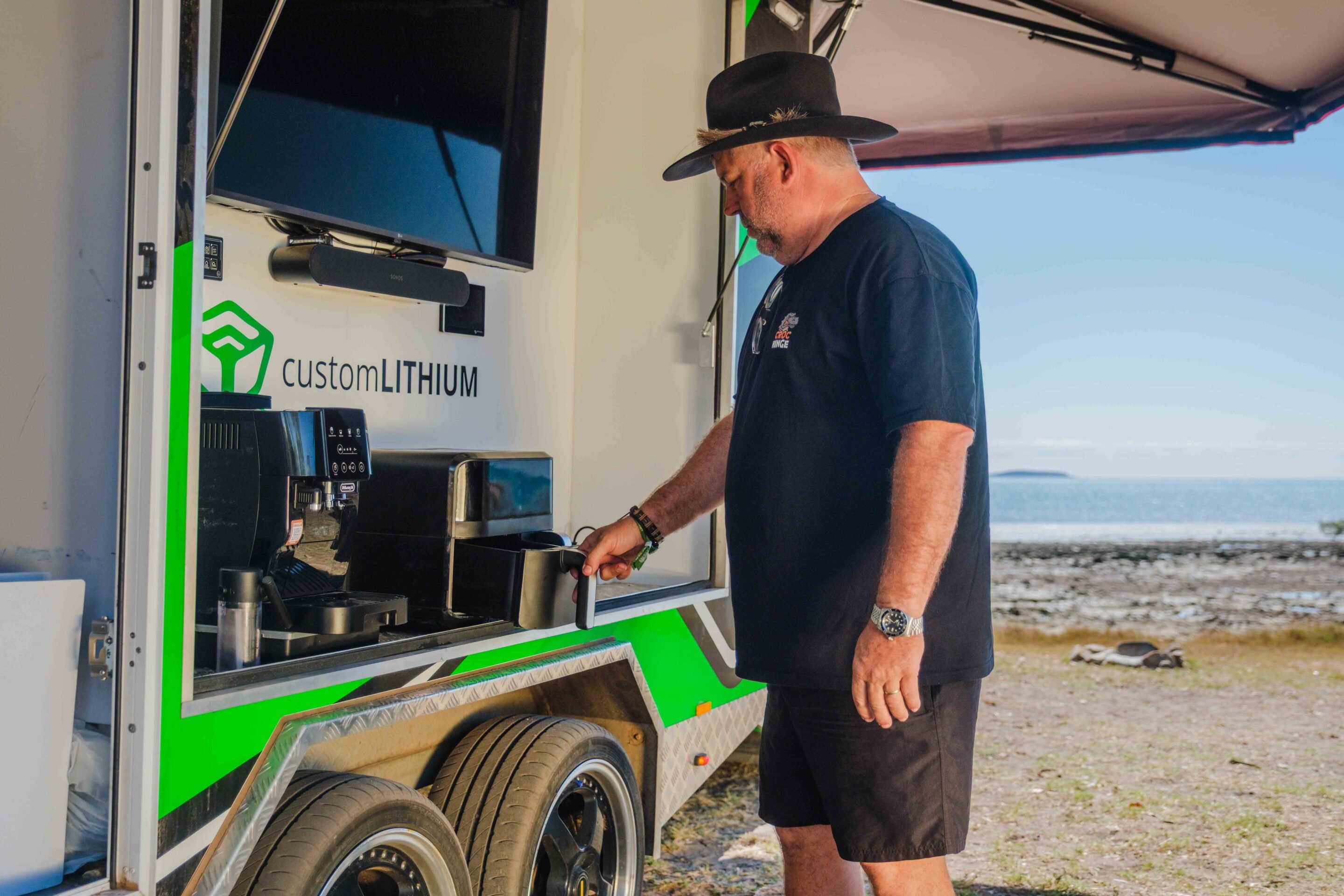
Practical uses for 4×4 and camping
- Running fridges, lights, water pumps, and induction cookers on extended trips.
- Powering winches, compressors, and recovery gear on the track.
- Supplying camping rigs, caravans, or camper trailers with reliable energy.
Final word
For off-road and camping setups, lithium batteries provide lighter, longer-lasting, and more consistent power than lead-acid units. Understanding their capabilities and limitations helps you choose the right system for your trips and ensures reliable performance in remote locations.
In 1930, in a modest workshop in Homebush, Sydney, George Lovell began winding springs. Born from necessity during the Depression, the operation was humble in scale but uncompromising in principle: products would be built to a standard, never down to a price.
95 years on, Lovells has become one of Australia’s most respected names in suspension, towing, and GVM and GCM upgrades. Its engineering supports applications ranging from family caravans and trade utes through to mining fleets and emergency service vehicles.
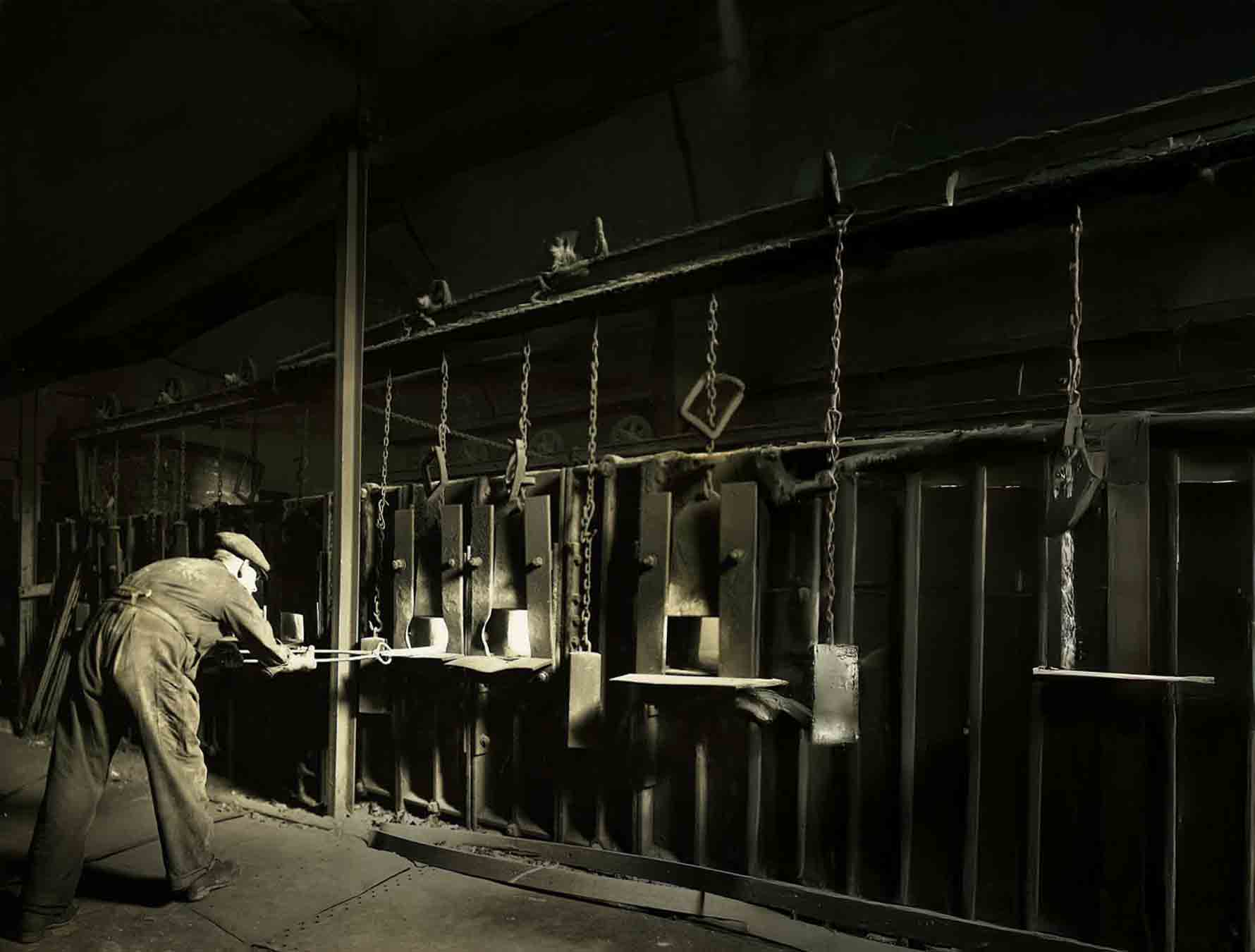
To mark its 95th year, Lovells has commenced construction of a $12 million flagship engineering and manufacturing centre in Newcastle. This facility will house state-of-the-art testing and design capabilities, from suspension fatigue testing to electric vehicle charging system development. Sustainability is also a core focus, with Lovells transitioning away from gas-powered processes in favour of induction heating technology to reduce emissions and improve efficiency.
The anniversary year also saw the launch of a flagship franchise in Osborne Park, Western Australia – the first to showcase Lovells’ refreshed brand identity. Alongside this expansion came a significant regulatory achievement, with Lovells becoming the first manufacturer approved for post-registration Gross Combination Mass (GCM) revisions in Western Australia.
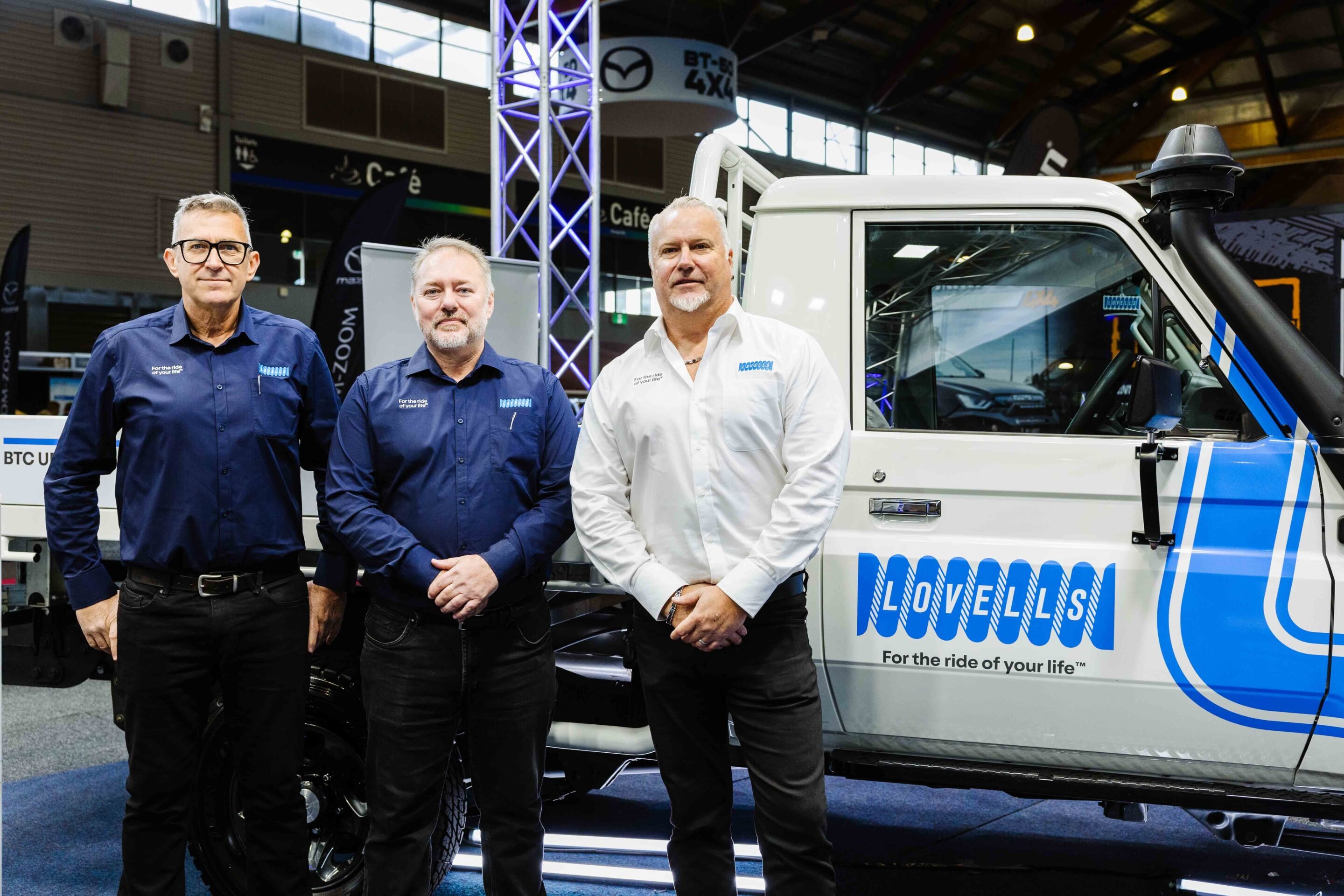
Beyond the workshop
Community and culture remain central to the Lovells story. In 2025, the company once again supported the Royal Flying Doctor Service’s ‘Outback Car Trek’ and ‘Drive 4×4 the Doc’, equipping vehicles vital to these fundraising events.
Motorsport also continues to play a key role in the brand’s identity. Lovells has secured naming rights for the 2025 Alpine Rally of East Gippsland and welcomed AFL legend Brent ‘Boomer’ Harvey as a brand ambassador. Harvey now fronts Full Travel, a new content series designed to connect Lovells with the next generation of drivers – reinforcing the brand’s commitment to performance and adventure.
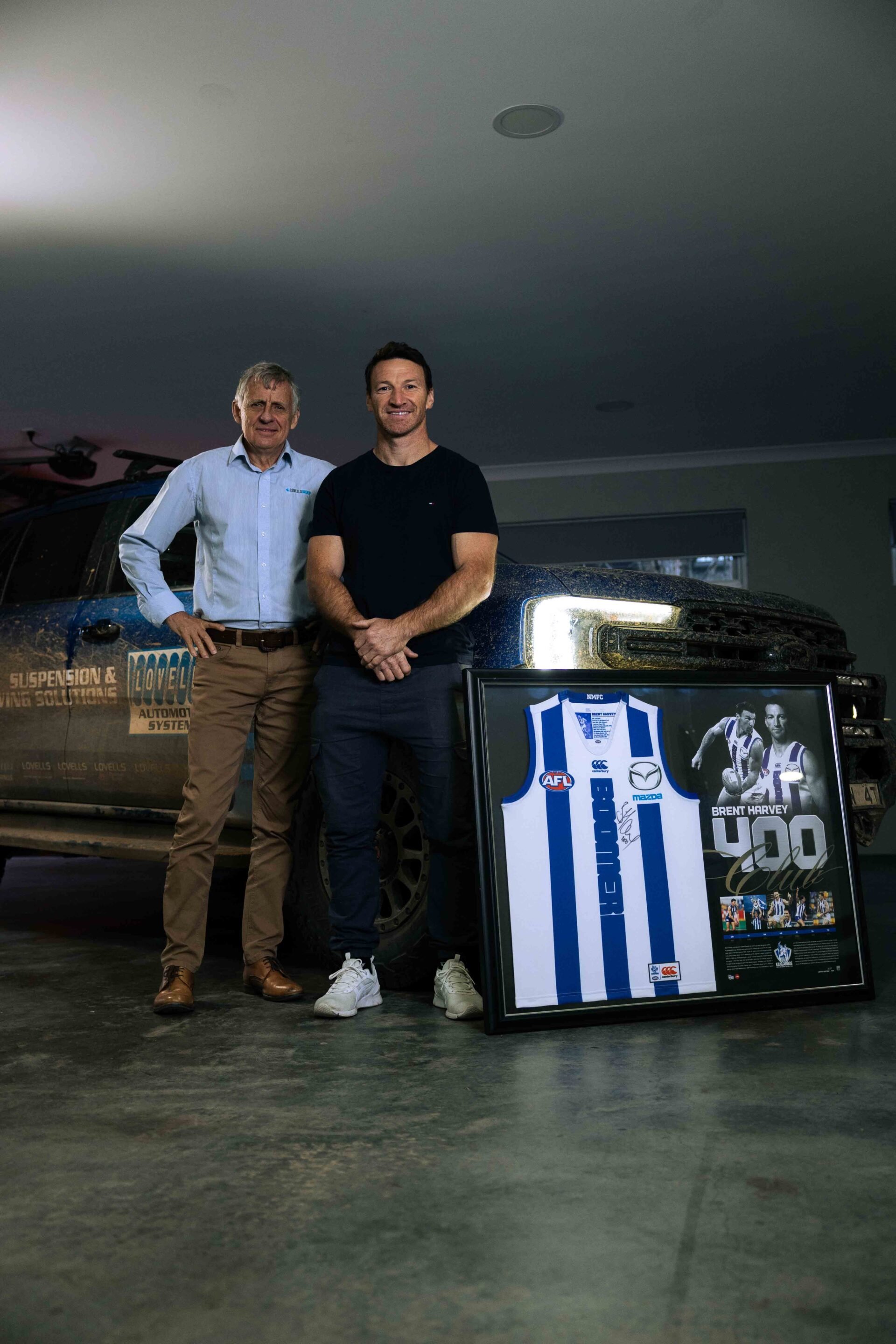
To unify these milestones, Lovells has implemented the most comprehensive rebrand in its history – modernising its image while honouring its heritage. As Managing Director Simon Crane notes: “We’re proud of what we’ve built over the last 95 years, but we’re even more excited about what’s next.”
From its beginnings in Homebush to its current national and international footprint, Lovells’ story is one of resilience, reinvention and commitment to quality. At 95, the company remains defined not only by the products it engineers, but by the trust it has built – and by its enduring promise: For the Ride of Your Life.
According to Thai publication Car250, Toyota is reportedly gearing up to launch the new HiLux in Thailand this November at the Thai Motor Expo.
The 42nd Thailand International Motor Expo will run from 29 November to 10 December 2025 at IMPACT Challenger, a major exhibition and convention centre located just north of Bangkok, known for hosting trade shows, expos and automotive launches.
Car250 lists the vehicle as the HiLux TRAVO, a name which appears specific to the Thai market. In other regions, the next-gen HiLux is expected to continue under the HiLux or Revo branding.
Spy photos earlier this year provided us with a glimpse of what to expect. The single-cab model shows a refreshed front end with slimmer headlights and a new grille, echoing the updates already spotted on dual-cab variants. Leaked shots of the dual-cab revealed a redesigned rear with updated tail-lights, while the mid-section remains largely unchanged – pointing to a substantial facelift rather than a full redesign.
Despite speculation of an all-new model, the HiLux is expected to remain on the IMV platform, rather than adopting Toyota’s TNGA-F architecture used by the Tundra, Prado and 300 Series.
Inside, leaked images hint at a major tech upgrade, including twin 12.3-inch screens for the instrument cluster and infotainment, replacing the current 8.0-inch display. The cabin design appears inspired by the LandCruiser Prado, with an infotainment setup similar to Toyota models sold overseas.
Under the bonnet, the familiar 1GD 2.8-litre and 2GD 2.4-litre four-cylinder turbo-diesels are expected to return, likely updated to meet stricter emissions standards.
There’s also speculation of a plug-in hybrid (PHEV) variant, possibly using a 2.5-litre petrol-electric setup similar to the RAV4 PHEV, joining diesel and mild-hybrid options to keep the HiLux competitive against rivals like the Ford Ranger and BYD Shark.
Most 4WDers carry a compressor of some sort – whether it’s for pumping up tyres after a day on the beach, a run across the Simpson, or the occasional blast of air to drive a power tool.
There are plenty of extras you can add to make a basic compressor more useful or convenient, but not all are worth the extra cash, space or weight. One that absolutely is, however, is the Tuff Terrain air hose reel.
Built tough for off-road life
Straight out of the box, the quality and durability of the Tuff Terrain hose reel stand out. The main body is a solid, full-aluminium unit – built to handle the knocks and bumps of off-road touring – and it can be mounted almost anywhere in your vehicle using the included mounting brackets.
The kit also comes with a selection of air hose connectors, including fittings compatible with both ARB and Nitto-style hoses, so it integrates easily with most existing compressor setups.
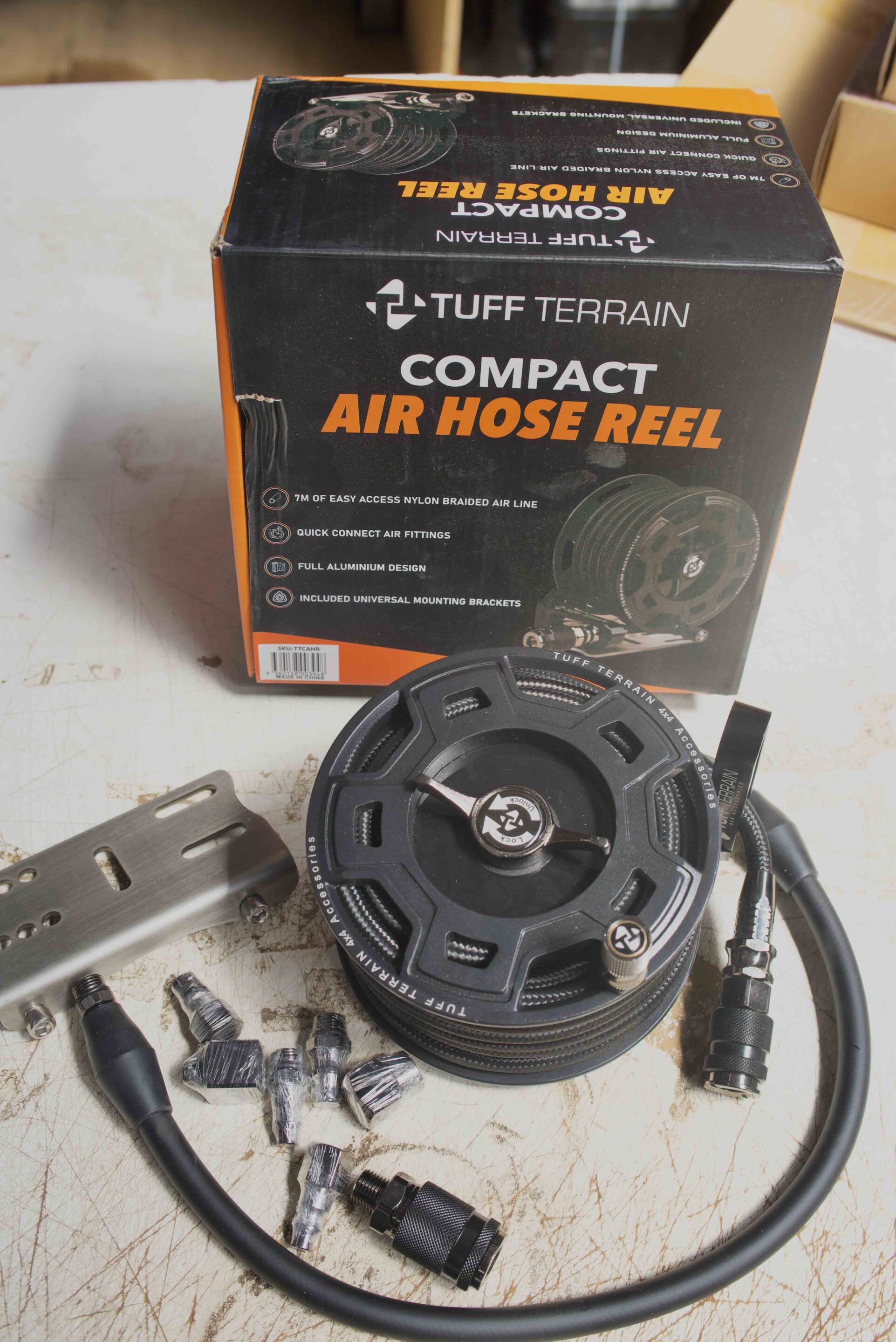
Long, flexible 7m hose
The 7-metre air hose comes fitted with a patented quick-connect fitting that locks in securely and makes tyre inflation quick and simple. An internal rubber hose with a protective nylon braid cover ensures durability, flexibility and resistance to wear and tear in harsh conditions.
We mounted the reel on the back of the cargo barrier in the Troopy, making it accessible through the gullwing windows. The hose easily reached all four tyres plus our camper trailer, with no hassles. Rated to withstand pressures up to 220psi, it’s more than capable of inflating any 4×4 tyre as well as running air tools.
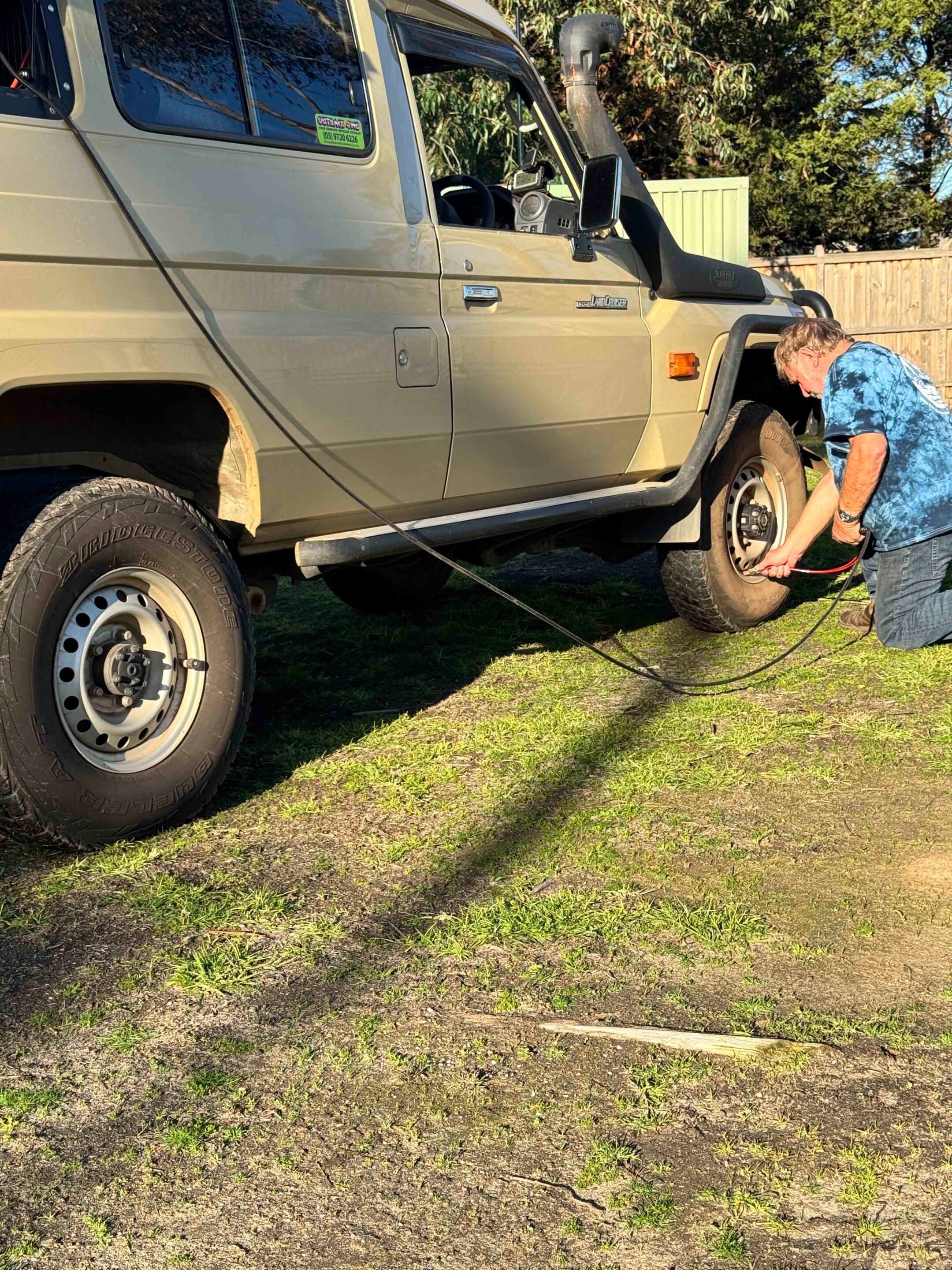
Easy storage and use
An aluminium hose guide ensures the hose winds evenly onto the drum, while a locking system prevents unwanted unravelling when travelling. The reel keeps the air hose tidy, compact and ready for instant use, with pack-up quick and straightforward.
Tuff Terrain now also offers a self-retracting version, making storage even easier for those who want maximum convenience.
Warranty and pricing
- Warranty: The Tuff Terrain air hose reel is backed by a three-year warranty.
- RRP: $380 (seen from as low as $300); $419-$440 (self-retracting unit)
The Holland Track, out in Western Australia’s eastern goldfields, had been on my bucket list for years – and it didn’t disappoint.
Following in the footsteps of the legendary John Holland, we traced what’s claimed to be the longest single cart track ever cut in WA. Originally carved to open up the goldfields, it slashed weeks off the journey for miners, families and traders heading inland in search of fortune.
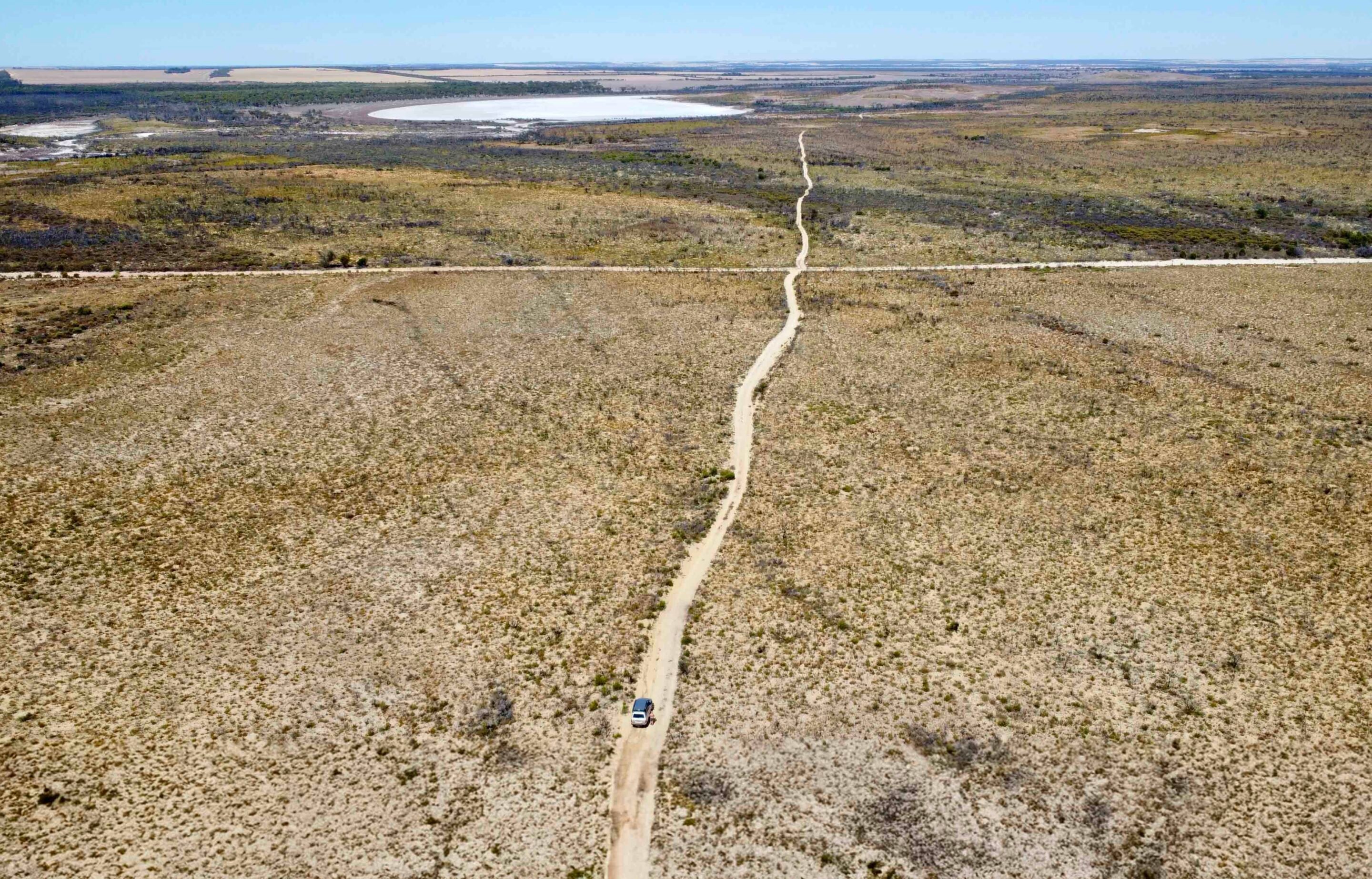
Gold Rush Beginnings
Around 1890, waves of hopeful prospectors were landing in Fremantle and Albany by steamship, all chasing the riches of WA’s booming goldfields. From seasoned miners to shopkeepers and families, they headed north on foot, pushing barrows or hauling carts. The push for a direct supply route soon followed – a way for local producers and traders to get goods to the goldfields faster.
John Holland’s Epic Achievement
Several earlier attempts to forge a route failed – one rider vanished without a trace, another party veered miles off course, and others were forced back by the brutal summer heat.
Then, in 1893, a 37-year-old bushman named John Holland stepped up. He didn’t just want to find a route – he wanted to open it immediately for carts and carriages. With his two brothers and another young companion, Holland set out after summer and, remarkably, cut the entire 500km track in just two months and four days – all without government support. Along the way, they passed rock mounds and granite holes, carving a path past water soaks that would become lifelines for those who followed.
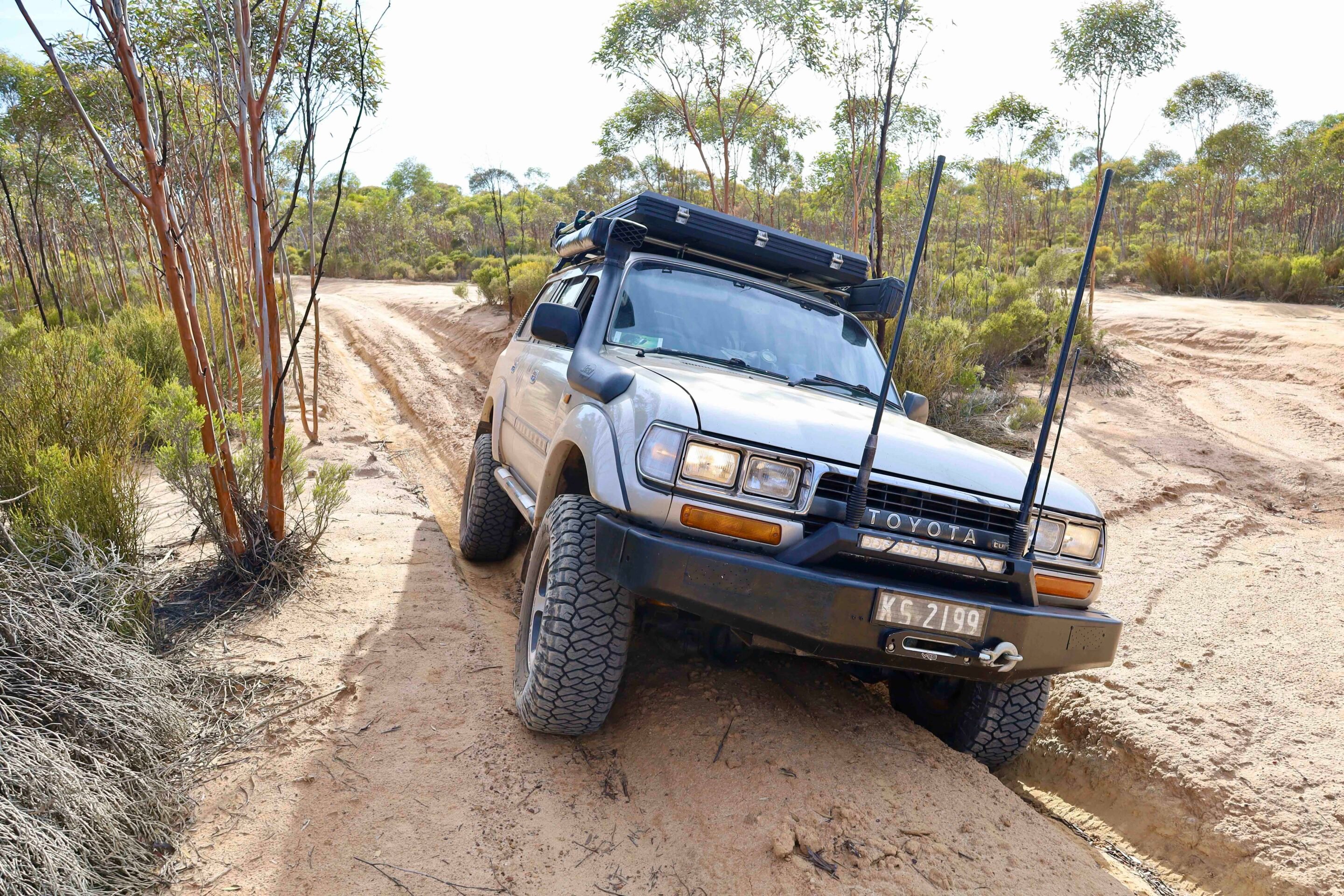
From Forgotten Track to Rediscovery
A few years after the Holland Track opened, a new rail line to Coolgardie slashed travel times from weeks to days, and traffic on the track quickly dried up.
Over the following decades, it became overgrown and largely forgotten. Between the 1950s and 1990s, various groups of enthusiasts and historians tried to retrace the original route. It wasn’t until 1992 that the track was successfully reopened – a team pushed through using compass bearings and visual cues of the old path, and pushing through with a tractor.
Historic Coolgardie
My starting point for the Holland Track was the historic town of Coolgardie, around 40km southwest of Kalgoorlie.
Once the third-largest town in WA, Coolgardie put itself on the map in 1892 when it sparked a gold rush that drew tens of thousands to the region. Dubbed “the mother of the Western Australian goldfields”, the town boomed with more than 30,000 people flocking to the area. The streets were built wide enough to turn a full camel train – but like many rush towns, it faded once richer finds were made where Kalgoorlie now stands.
These days, Coolgardie is a quieter place, lined with heritage buildings. It’s where four-trailer road trains split their loads, and tourists wander the parks, museums and streets in search of relics from a wilder time. The first Holland Track sign led me south out of Coolgardie along Victoria Rock Road for about 40km. That’s where I found the turn-off to the track proper, marked by several info boards.
The most important is the Holland Track ‘code of conduct’ sign, installed by the LandCruiser Club of WA. It outlines key guidelines – including using UHF channel 28, recommended tyre pressures, and six practical tips for safe and respectful travel.

The Holland Track can be tackled in short sections or stretched out over a full week if you want to run it end to end. I planned to cover the northern half before peeling off toward Hyden to check out Wave Rock. I was lucky enough to strike fine weather on the Holland Track. While researching the trip, I’d seen plenty of social media clips showing messy recoveries when it’s wet – but in the dry, it was no trouble at all. There are even chicken tracks around the tougher sections.
The drive is peaceful, winding through sand plains, woodlands and granite rock platforms. I stopped at all the signposted points of interest along the way, which meant I was averaging about 100km a day. Most of these sites tie into the early surveying of the track and region – from rocky outcrops that offered water or a view across the plains, to blazed trees and historic campsites. They’re all worth a look if you’ve got the time.
The modern Holland Track generally follows the original route cut by John Holland, though it often veers off to protect sensitive areas and preserve historic sections. Claypans are scattered through the region, but the current track wisely skirts around them to prevent damage. In places, the track narrows to a single lane, and the scrub starts closing in – so bush pinstripes are pretty much unavoidable.
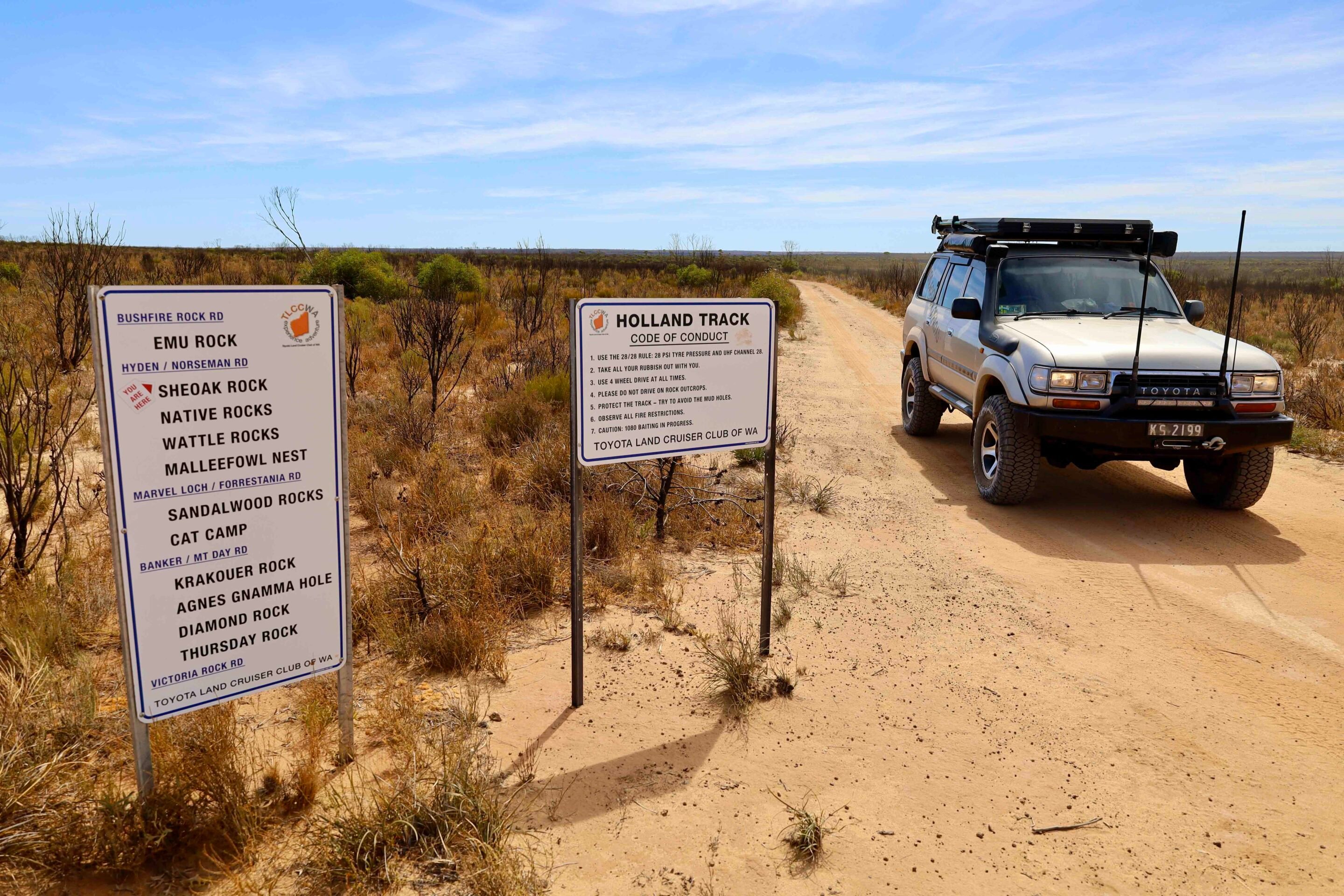
Free camping is allowed along much of the track, but at Victoria Rock Reserve you’ll find designated bays with barbecues, tables and toilets. Even if you’re just passing through, it’s worth a stop to climb the rock and take in the stunning 360-degree views. John Holland named the rock in 1893 after Queen Victoria, and it was here his team built a stone cairn and flagpole on the summit. Another highlight along the northern section is the crossing of one of WA’s State Barrier Fences.
This 260km stretch of rabbit-proof fencing was built in 1954 to keep rabbits and emus out of farmland in the wheatbelt around Bonnie Rock. Unfortunately, the government of the day ran out of funding – and the fence ends rather abruptly.
Timber Industry Legacy
In the surrounding woodlands, sandalwood was once highly prized, and remnants of old groves can still be found near Sandalwood Rocks – a spot where Holland camped in 1893.
While a few small stands remain, most of the original thickets have never regenerated. When gold was discovered in the rich fields around Coolgardie and Kalgoorlie, timber was in huge demand to power steam boilers for stampers and other machinery.
Across the region that the Holland Track now cuts through, more than a dozen timber tramways once ran through the bush, carting wood to the settlements. It was big business, providing jobs for timber cutters, tram workers, carters and storemen. Timber was felled several miles from the tram lines, usually by hardworking Italian and Slav migrants who cut the logs into manageable lengths.
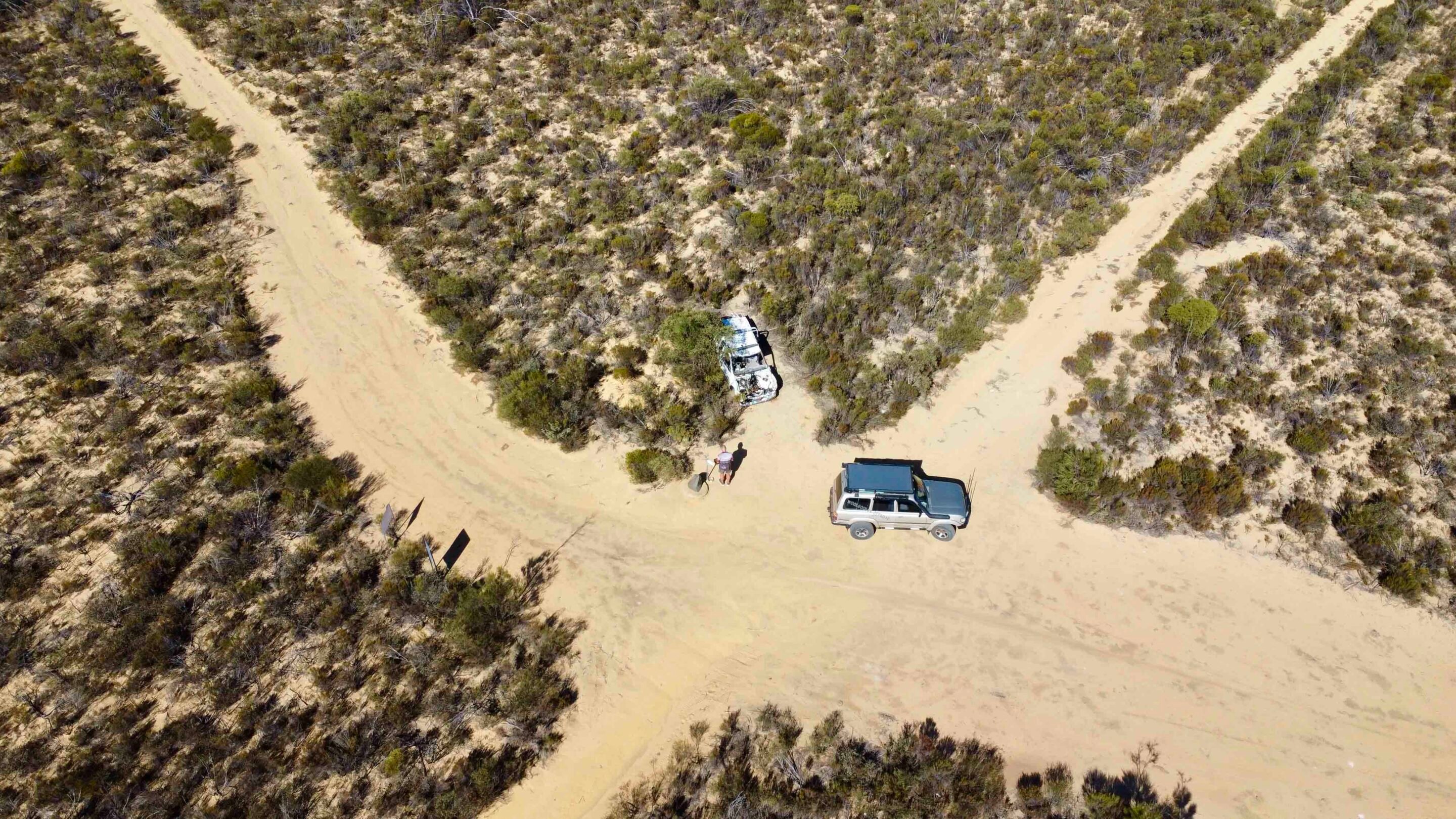
These were then carted and stacked alongside the tracks for collection. As local supplies dried up, new feeder lines were laid into better stands of timber. Over time, the bush within a 35km radius of Cave Hill was stripped bare – nothing left but stumps. In 1937, the entire operation was shifted to Boulder, southeast of Kalgoorlie, where fresh lines were laid into untouched scrub. By 1964, it all came to an end.
Around the Cave Hill area, at the northern end of the Holland Track, you can still spot remnants of the old timber operations. Stone-walled run-off channels once fed dams, pipelines led to overhead tanks for steam engines, and the sawmill site still shows signs of its former life.
Wave Rock Detour
My journey along the Holland Track ended about halfway, where I diverted to Hyden to visit the world-famous Wave Rock.
It shot to fame after winning the 1964 Kodak International Photo Competition in New York – and the rest, as they say, is history. Stretching 110 metres long and rising over 15 metres high, it’s an impressive sight. But Wave Rock is just one part of what’s known as Hyden Rock – a much larger formation that includes a hand-built granite wall used to divert water into the town’s old dam, the Hippo’s Yawn rock formation to the east, and the weathered outcrop known as The Breakers. Formed by millions of years of erosion, Hyden Rock is estimated to be around 2.7 billion years old.

Journey Through History
While I only explored the top half of the Holland Track, there’s still plenty more to discover – giant granite monoliths, remote bush camps, abandoned farm and steam machinery, and the weathered remains of old tramways and timber camps. The Holland Track isn’t just a drive through the scrub – it’s a journey through history.
Travel planner
Where: The Holland Track stretches 500km from Broomehill in WA’s south to Coolgardie in the eastern goldfields. Cut in the early 1890s, it was originally built as a shortcut for miners heading to the booming Kalgoorlie goldfields.
What to See and Do: The track is packed with natural and historical highlights – massive granite outcrops, bush camps, forest sections, and wide-open views. It’s well signposted with plenty of stops, and offers free camping along the way. While not extreme, the track can be challenging in sections, especially after rain.
More Info: For detailed trip planning, grab a copy of Explore the Holland Track, available online or from the Kalgoorlie Visitor Centre. The track is remote and requires full preparation – carry extra food, fuel and water. Telstra has patchy reception along the way.
For decades now, Lexus has been waving its luxury wand over parent company Toyota’s LandCruiser offerings to make them appeal to a different clientele than the traditional Cruiser buyer.
Think Range Rovers with lashings of leather hides, a smattering of woodgrain trim and premium fit-out to bring in buyers from the luxury SUV segment. The latest off-road offerings from Lexus are the updated LX range, which arrived alongside the refreshed LandCruiser 300 Series on which the current LX is based.
Significantly, the 2025 LX update introduced an Overtrail variant to the line-up – a model designed to appeal to clientele who want to get their Lexus dirty and make the most of its LandCruiser underpinnings. The LX Overtrail follows the launch of the GX550 Overtrail earlier this year, which gave the same off-road-focused treatment to the 250 Series Prado.
JUMP AHEAD
- Lexus LX Overtrail explained
- Luxury meets off-road capability
- How the LX600 Overtrail drives on- and off-road
- Verdict: A luxury 4×4 with real ability
- Specs
Lexus LX Overtrail explained
The LX Overtrail is offered with either petrol or diesel power.
The LX Overtrail 500d uses the same V6 diesel found in the LC300 and starts at $182,300, while the LX600 Overtrail runs a V6 petrol engine and starts at $185,800. Both Overtrail variants are five-seat only, leaving the rear section open for cargo. Seven-seat LXs are available in other trims, but not as an Overtrail – and they miss out on the auxiliary fuel tank, limiting capacity to 80 litres. The five-seat Overtrails, by contrast, can carry 110 litres of petrol or diesel, depending on the model.
For the record, the LX600 has an ADR combined-cycle fuel consumption rating of 11.9L/100km, while the LX500d is rated at 8.9L/100km.
We have the LX600 Overtrail variant on test here, powered by a 3.5-litre twin-turbocharged petrol V6 producing a healthy 305kW at 5200rpm and 650Nm. That’s plenty of torque on tap for those prepared to forgo the diesel option. Interestingly, this engine in the GX550 produces the same 650Nm but is limited to 260kW, and with different engine codes, the two units are not exactly the same.
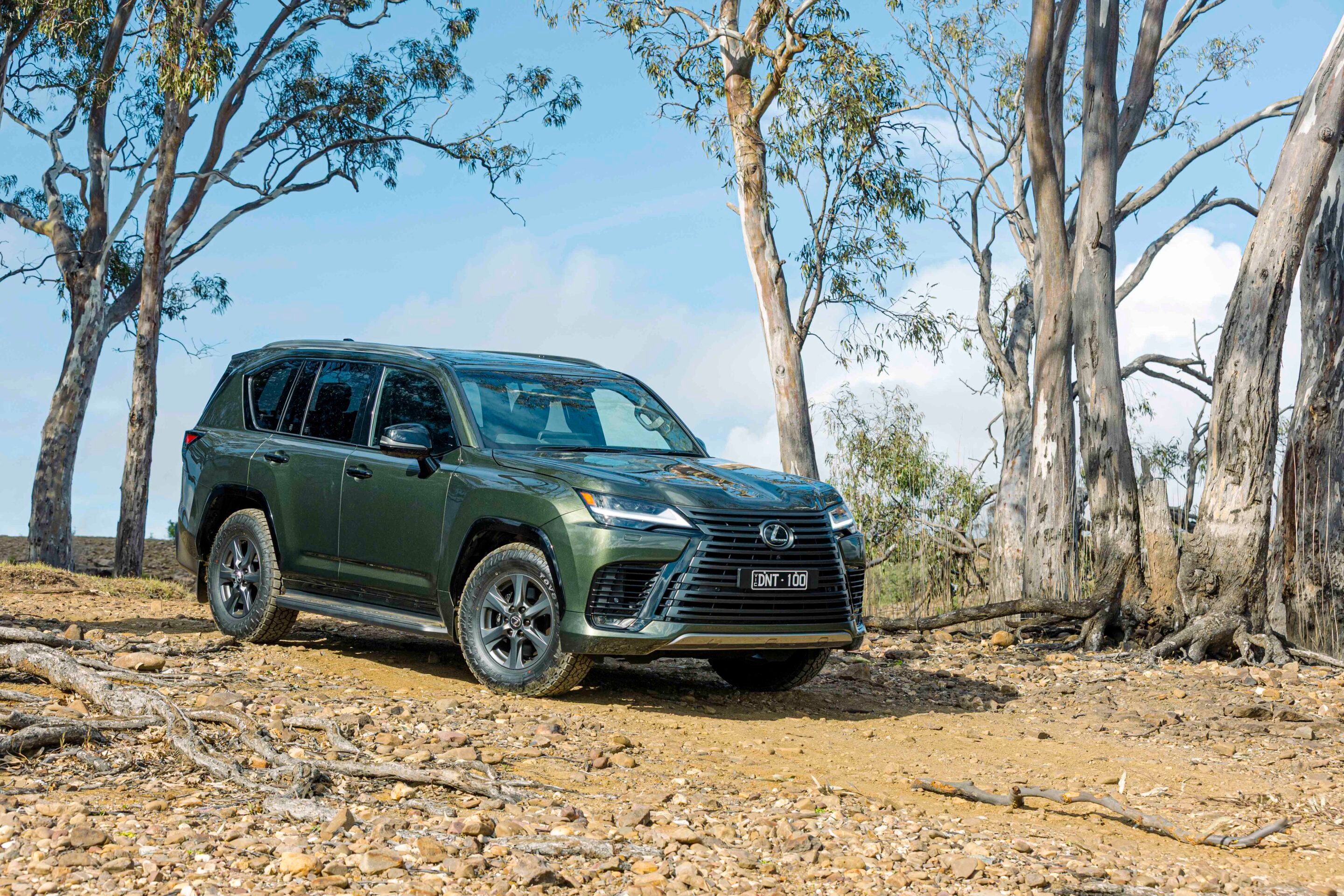
Differentiating the Overtrail from its LX siblings is the fitment of 18-inch alloy wheels shod with 265/70R18 Toyo Open Country all-terrain tyres, chosen for improved off-road performance. This sensible wheel-and-tyre combination replaces the oversized alloys – up to 22-inch – and low-profile road rubber fitted to other LX grades.
Those wheels and tyres are backed by locking front and rear differentials, Crawl Control, and a Multi-Terrain Select system to boost the LX’s off-road ability. Model-specific front and rear bumpers improve clearance at each end, while black exterior highlights set the Overtrail apart – though its smaller wheels look a bit out of place against the big, slab-sided LX profile.
The Overtrail rides on Lexus’s Active Height Control (AHC) suspension, which uses hydraulic pressure to raise or lower the vehicle for extra clearance when needed. In high range, AHC can lift the LX by up to 73mm, while low range allows 83mm – with a further 20mm (103mm total) temporarily available if the system senses the vehicle is stuck.
The system automatically adjusts ride height depending on the drive mode or low-range setting, and also keeps the vehicle level. For easier access, it can drop the body by 27mm when parked. Because it’s hydraulic rather than air-based, there’s no compromise in ride quality – though the suspension does feel noticeably firmer when extended to its maximum height.
Luxury meets off-road capability
There’s no compromise on the styling or features inside the LX Overtrail – it’s every bit as plush as you’d expect from a $185K Lexus.
Headlining the 2025 updates is a new 12.3-inch multimedia display, which controls everything from sat-nav and entertainment to vehicle drive modes. The LX now features wireless Apple CarPlay and Android Auto connectivity, along with a wireless phone charging pad.
Lexus has long set the benchmark for OEM sound systems, and the Overtrail is no exception. A premium Mark Levinson audio setup delivers crystal-clear sound through no fewer than 25 speakers.
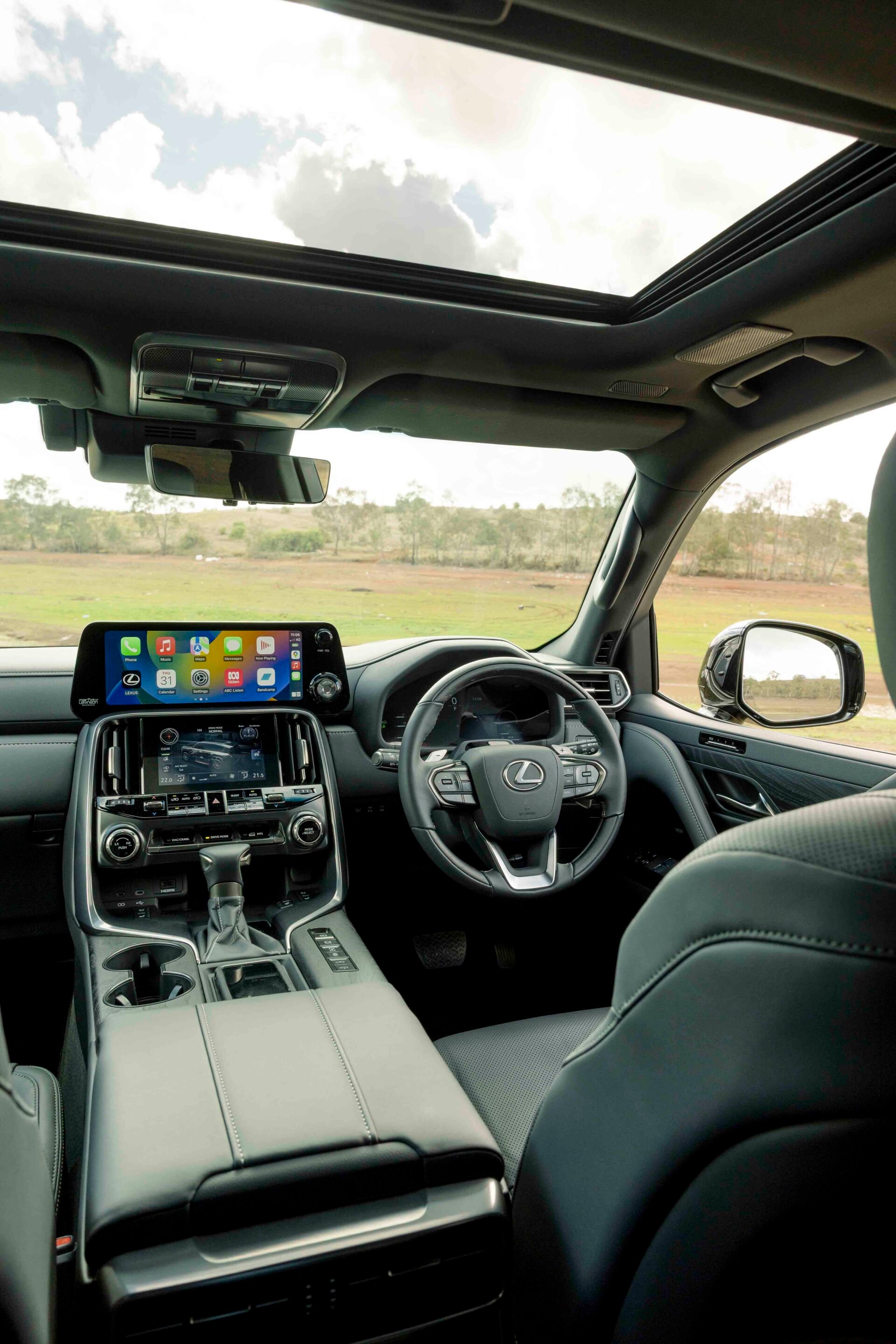
There’s a luxury feel throughout the cabin, with quality leather trim set off by model-specific green stitching on the seats. Front passengers get heating, ventilation and massage functions, while the rear outboard seats are also heated and ventilated. The steering wheel is heated too, with automatic temperature control for both the tiller and seats. The steering column offers power adjustment for reach and height, and there’s a digital rear-vision mirror and head-up display for the driver.
The Lexus/Toyota Safety Sense suite of advanced driver assistance systems ensures the LX is well covered when it comes to protecting both passengers and pedestrians.
How the LX600 Overtrail drives on- and off-road
On the road, the LX600 Overtrail drives exactly as you’d expect of a large luxury wagon. The V6 is smooth, quiet and effortlessly powerful, with the 10-speed auto shifting almost imperceptibly unless you bury the throttle. Press on and the abundant torque shrugs off the LX’s considerable mass, making overtakes and long climbs a relaxed affair.
The cabin is plush, spacious and comfortable giving the feeling that you could easily drive in it all day long. It’s so refined that you almost feel guilty leaving the blacktop for dirt and ruts – but with the LX’s LandCruiser DNA, you can be confident the Overtrail is up to the task.
On gravel and dirt tracks, the taller sidewalls of the 18-inch tyres soak up bumps far better than low-profile rubber on larger rims ever could. The Toyo all-terrains inspire confidence that you’ll make it wherever you’re headed.
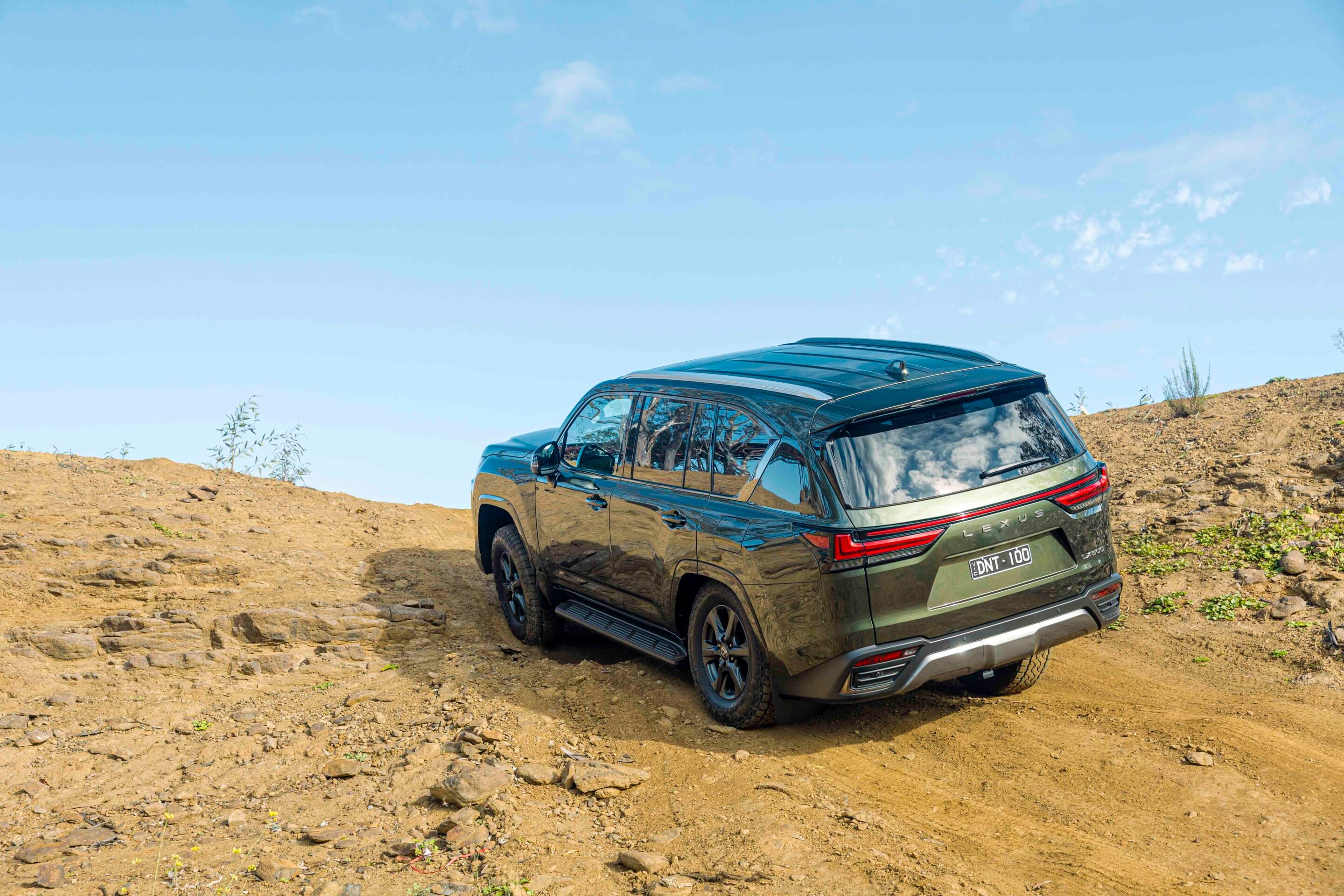
Things aren’t as straightforward as they should be when the track steepens and you need to dig into the LX’s drivetrain. Locking the centre diff is easy enough – there’s a button right by your left knee – but the high/low-range selector dial is on the far side of the console, nowhere near where you’d expect it in a Toyota-based product. As for the front and rear diff-lock switches? They’re hidden away under the dash to the left of the steering column, well out of sight.
With only the MTS set to Rock mode, the Overtrail failed on the first steep climb, making it up only after the centre diff was locked – fair enough. Selecting low range prompts the AHC to raise the suspension, but this in turn reduces available downward travel, so the LX jolts and bumps its way through ruts and holes on an ascent. If you don’t need the extra clearance, it’s smoother and quieter to tackle the climb at a lower suspension setting, where the springs and shocks can do their job properly. Maximum height should be reserved for when you really need it.
The rear axle delivers that lovely, supple articulation Toyota 4x4s are famous for, and the traction control is sharp and decisive, meaning you can leave the locking diffs alone for all but the most challenging tracks.
Verdict: A luxury 4×4 with real ability
With a legacy stretching from the 100 and 200 Series to today’s 300 Series–based LX, Lexus 4x4s have cemented their place as true Range Rover rivals in the luxury off-road space.
While the latest LX commands a hefty price, it still undercuts a Rangie or a G-Wagen – and offers the proven reliability and capability that comes with its LandCruiser DNA. The addition of the Overtrail variants allows the LX to fully exploit its LandCruiser underpinnings and abilities, while adding a rare level of luxury to the off-road segment. It’s a combination that will appeal to buyers seeking both attributes – particularly those towing large horse floats or boats, who’ll appreciate the 3500kg braked towing capacity.
The Overtrail is also an option for those who’ve long admired the style and luxury of a Lexus but dismissed it due to the oversized wheels and low-profile tyres offered on other variants. With its more practical wheel and tyre package, the Overtrail gives buyers the best of both worlds – whether they choose petrol or diesel power.
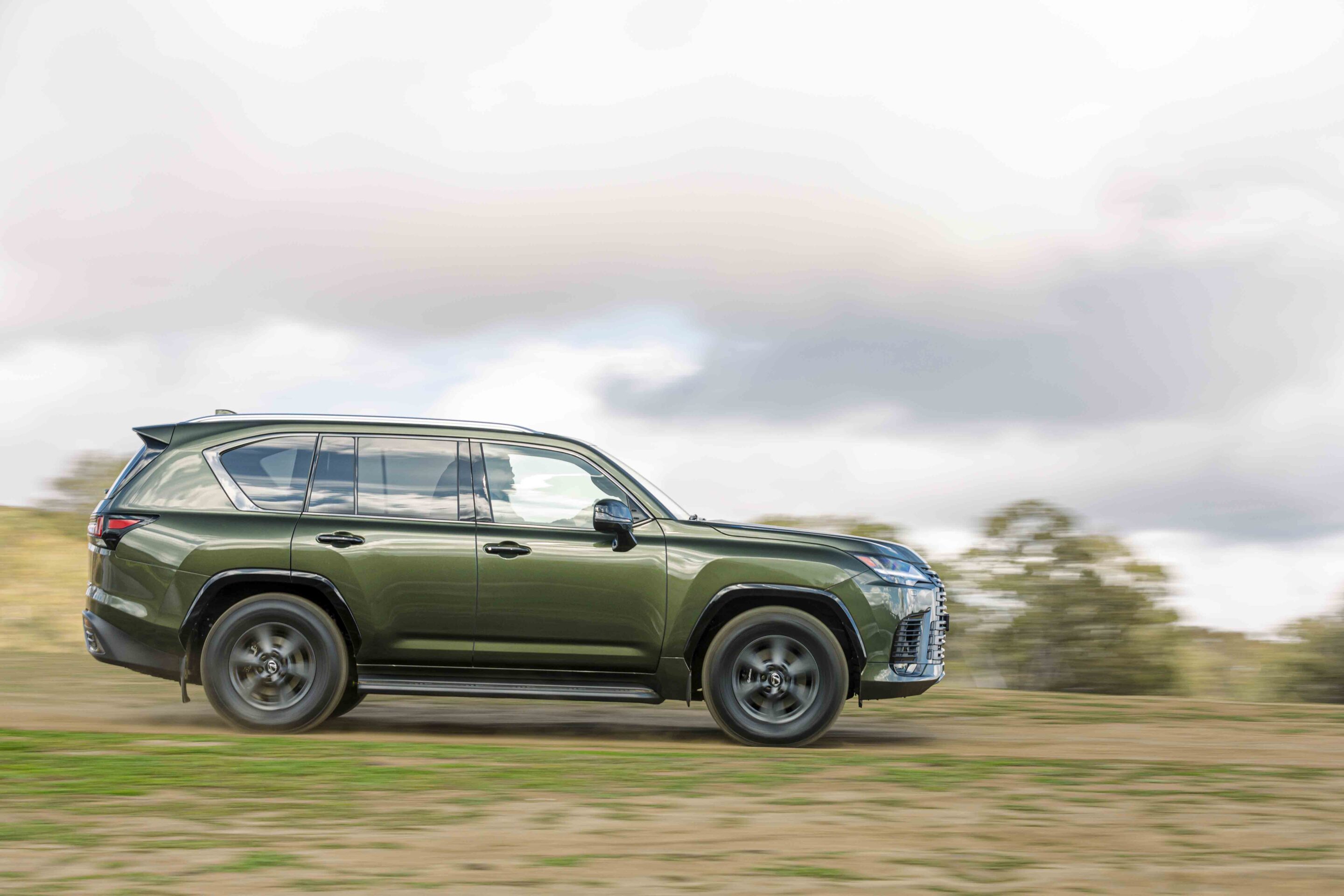
Specs
| Price | $185,800 +ORC |
|---|---|
| Engine | Twin turbo V6 petrol |
| Capacity | 3445cc |
| Max power | 305kW @ 5200rpm |
| Max torque | 650 @ 2000-3600rpm |
| Transmission | 10-speed automatic |
| 4×4 system | Full-time/dual range. Locking front, centre and rear differentials |
| Construction | 5-door wagon on separate chassis |
| Front suspension | IFS with wishbones and coils |
| Rear suspension | Live axle with multilink and coils |
| Tyres | 265/70R18 on alloy wheels |
| Kerb weight | 2680kg |
| GVM | 3280kg |
| Towing capacity | 3500kg |
| Payload | 1000kg |
| Seats | 5 |
| Fuel tank | 110L (PULP) |
| ADR fuel consumption | 11.9L/100km |
| On test fuel consumption | 14.1L/100km |
| Approach angle | 23 |
| Departure angle | 22 |
| Ground clearance | 210mm |
Mazda has added a new 2.2-litre turbo-diesel engine to the BT-50 range, replacing the smaller 1.9 and bringing more grunt and the option of 4WD.
The engine is the same four-cylinder recently rolled out in the Isuzu D-MAX and MU-X. It makes 120kW at 3600rpm and 400Nm from 1600rpm – 10kW and 50Nm more than the outgoing 1.9. Power is sent through a new Aisin eight-speed auto, which also helps trim fuel use by around 0.7L/100km and drops CO2 emissions by up to 17g/km.
This 2.2 is only available in the entry-level XS grade, offered as a Single Cab Chassis, Dual Cab Chassis, or Dual Cab Pickup. Standard kit includes LED headlights, adaptive cruise with stop-and-go, reversing camera, and wireless phone connectivity. The Dual Cab Pickup scores alloy wheels, while the rest keep steel.
Unlike the old 1.9, buyers can now spec the 2.2 as a 4×4 Dual Cab – opening it up as a more useful platform for touring or fleet work.
Elsewhere in the BT-50 line-up, the 3.0-litre engine gets idle stop-start, which Mazda says can cut fuel use by up to 11 per cent, while XTR and GT 4×4 Dual Cab Chassis models now come with a towbar as standard. The range continues unchanged with XS, XT, XTR, GT and SP grades.
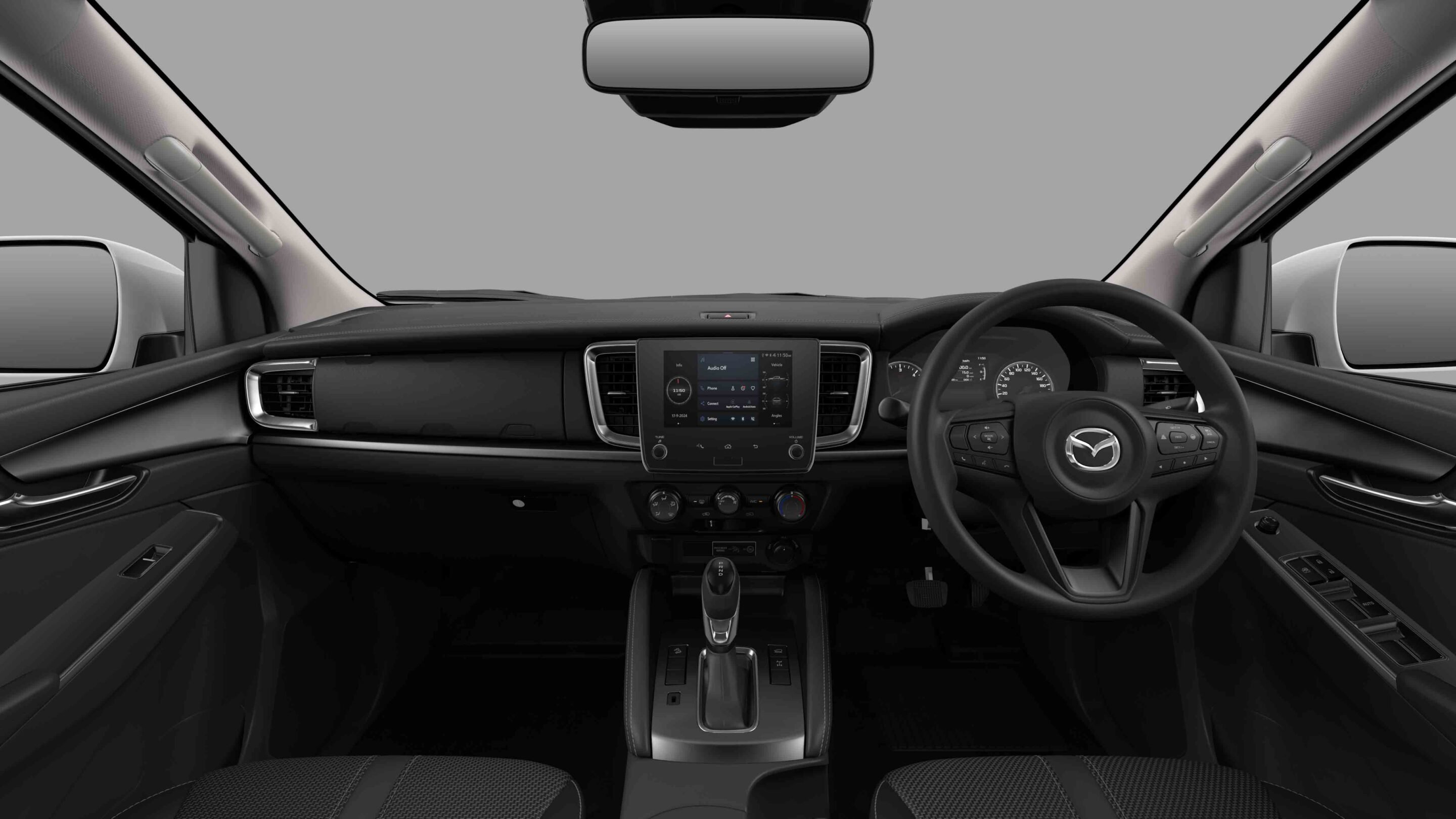
The updated BT-50 goes on sale nationwide from October, with Mazda Genuine Accessories available and covered by a five-year, unlimited-kilometre warranty when fitted before delivery.
The shared 2.2-litre update is another reminder of the close collaboration between Mazda and Isuzu, with both brands now co-developing the BT-50 and D-Max platforms and powertrains.
Pricing
| BT-50 Model Grade | Engine | Drivetrain | Combined Fuel Economy (L/100km) | CO2 Emissions (g/km) | MLP |
|---|---|---|---|---|---|
| Single Cab Chassis XS | 2.2L 4-cyl diesel (with Idle Stop System) | 4×2 | 6.9 (1.9L = 7.0) | 183 (1.9L = 184) | $37,900 |
| Single Cab Chassis XT | 3.0L 4-cyl diesel (with Idle Stop System) | 4×2 | 7.8 (-0.2 vs. previous 3.0L) | 204 (-3 vs. previous 3.0L) | $40,400 |
| Freestyle Cab Chassis XT | 3.0L 4-cyl diesel (with Idle Stop System) | 4×2 | 7.8 (-0.2 vs. previous 3.0L) | 204 (-3 vs. previous 3.0L) | $44,000 |
| Dual Cab Chassis XT | 3.0L 4-cyl diesel (with Idle Stop System) | 4×2 | 7.8 (-0.2 vs. previous 3.0L) | 204 (-3 vs. previous 3.0L) | $47,610 |
| Dual Cab Pickup XS | 2.2L 4-cyl diesel (with Idle Stop System) | 4×2 | 6.3 | 167 | $46,710 |
| Dual Cab Pickup XT | 3.0L 4-cyl diesel (with Idle Stop System) | 4×2 | 7.1 (-0.6 vs. previous 3.0L) | 185 (-15 vs. previous 3.0L) | $49,210 |
| Dual Cab Pickup XTR | 3.0L 4-cyl diesel (with Idle Stop System) | 4×2 | 7.1 (-0.9 vs. previous 3.0L) | 187 (-20 vs. previous 3.0L) | $54,240 |
| Single Cab Chassis XT | 3.0L 4-cyl diesel (with Idle Stop System) | 4×4 | 7.8 (-0.2 vs. previous 3.0L) | 204 (-3 vs. previous 3.0L) | $48,250 |
| Freestyle Cab Chassis XT | 3.0L 4-cyl diesel (with Idle Stop System | 4×4 | 7.8 (-0.2 vs. previous 3.0L) | 204 (-3 vs. previous 3.0L) | $52,000 |
| Dual Cab Chassis XS | 2.2L 4-cyl diesel (with Idle Stop System) | 4×4 | 7.1 | 188 | $53,120 |
| Dual Cab Chassis XT | 3.0L 4-cyl diesel (with Idle Stop System) | 4×4 | 7.8 (-0.2 vs. previous 3.0L) | 204 (-3 vs. previous 3.0L) | $55,620 |
| Dual Cab Chassis XTR | 3.0L 4-cyl diesel (with Idle Stop System) | 4×4 | 7.8 (-0.2 vs. previous 3.0L) | 204 (-3 vs. previous 3.0L) | $61,100 |
| Dual Cab Chassis GT | 3.0L 4-cyl diesel (with Idle Stop System) | 4×4 | 7.8 (-0.2 vs. previous 3.0L) | 204 (-3 vs. previous 3.0L) | $64,520 |
| Dual Cab Pickup XS | 2.2L 4-cyl diesel (with Idle Stop System) | 4×4 | 6.6 | 174 | $54,720 |
| Dual Cab Pickup XT | 3.0L 4-cyl diesel (with Idle Stop System) | 4×4 | 7.1 (-0.9 vs. previous 3.0L) | 187 (-20 vs. previous 3.0L) | $57,220 |
| Dual Cab Pickup XTR | 3.0L 4-cyl diesel (with Idle Stop System) | 4×4 | 7.1 (-0.9 vs. previous 3.0L) | 187 (-20 vs. previous 3.0L) | $63,200 |
| Dual Cab Pickup GT | 3.0L 4-cyl diesel (with Idle Stop System) | 4×4 | 7.1 (-0.9 vs. previous 3.0L) | 187 (-20 vs. previous 3.0L) | $66,620 |
| Dual Cab Pickup SP | 3.0L 4-cyl diesel (with Idle Stop System) | 4×4 | 7.8 (-0.2 vs. previous 3.0L) | 204 (-3 vs. previous 3.0L) | $71,950 |